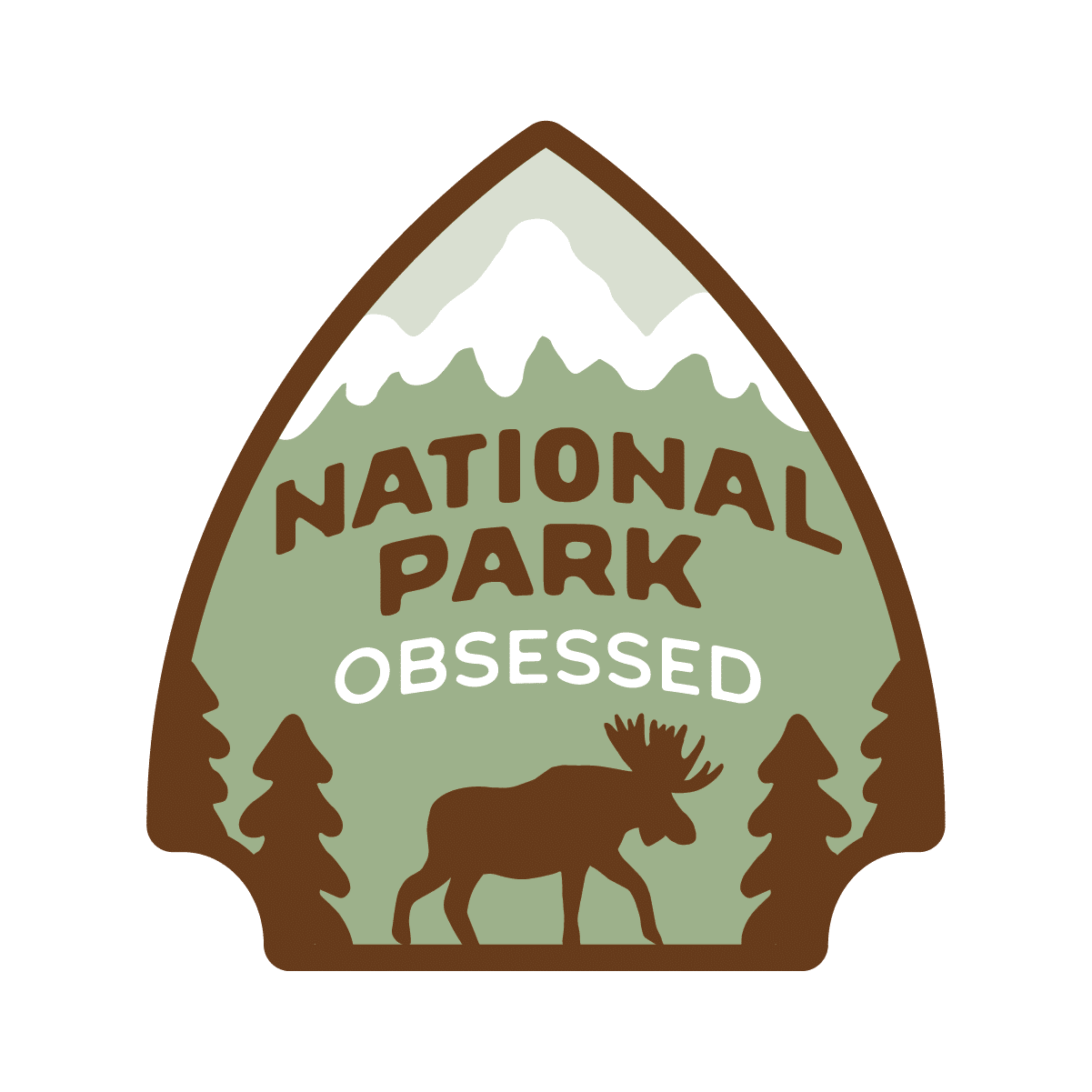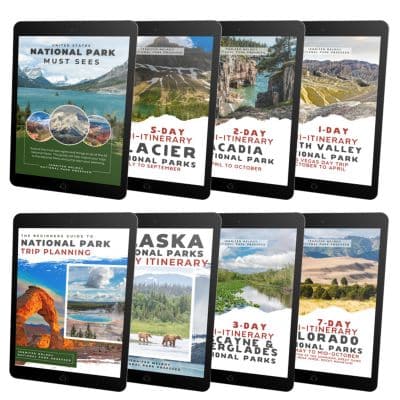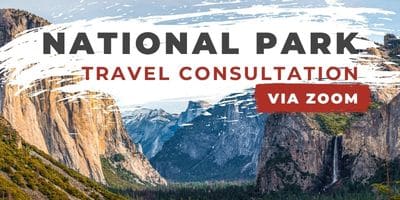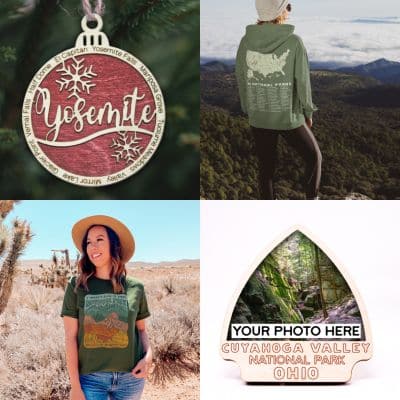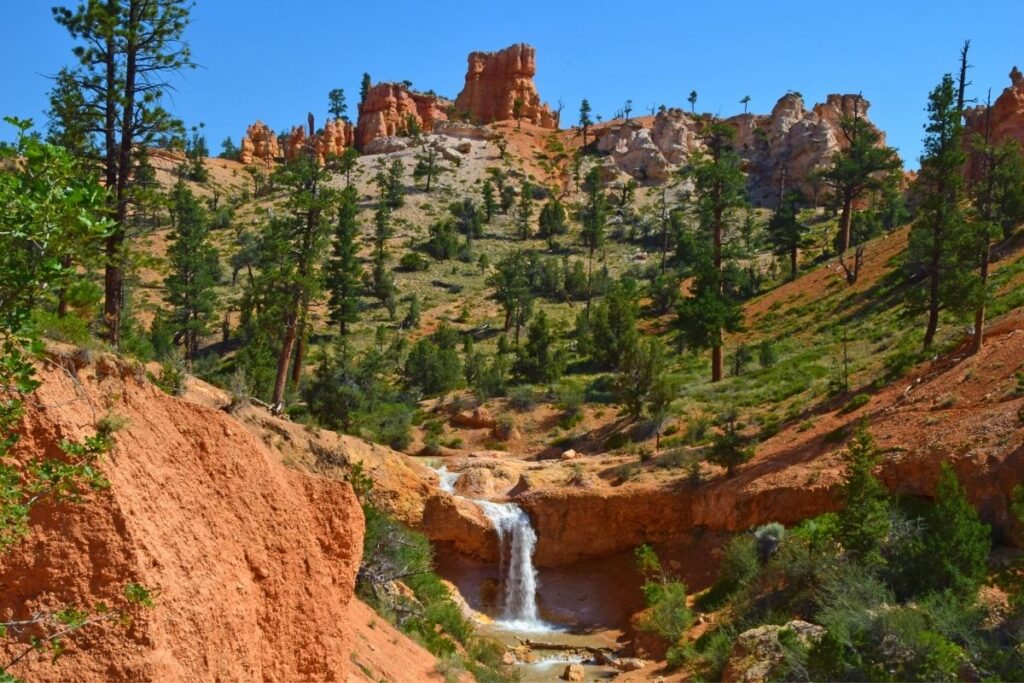
Southwestern National Parks: The Definitive List for 2022
- Jennifer Melroy
- Last Modified January 22, 2022
- First Published on October 5, 2021
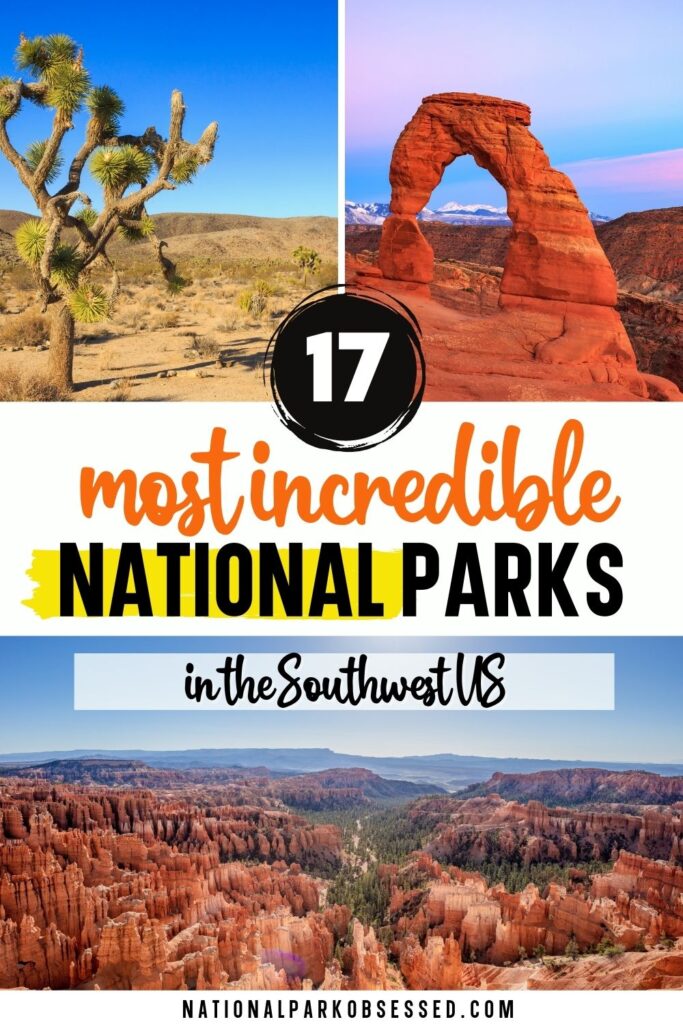
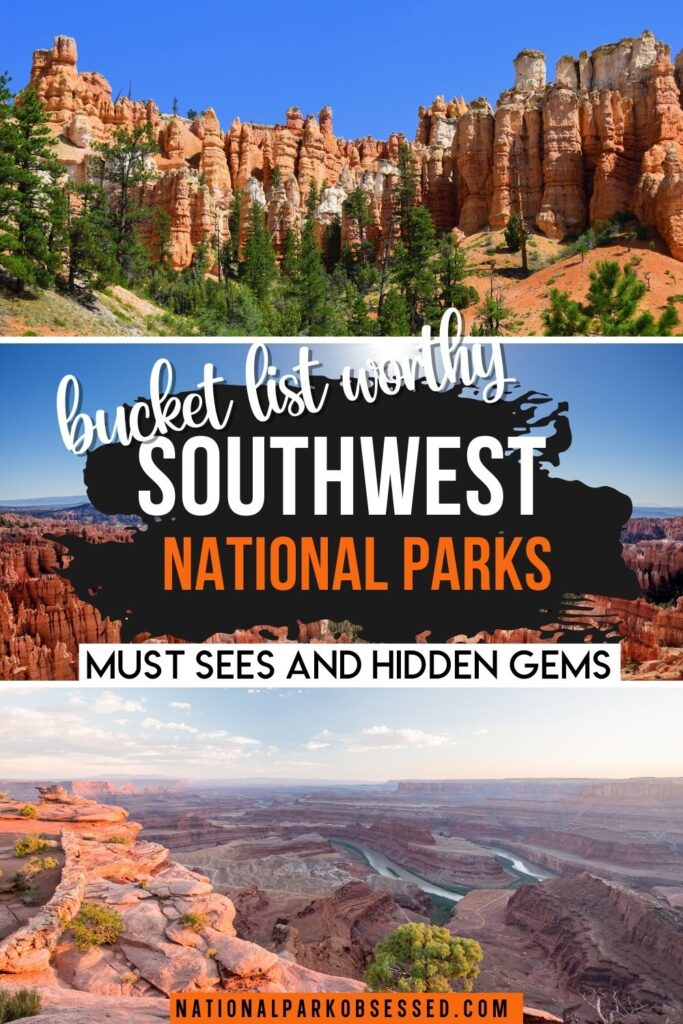
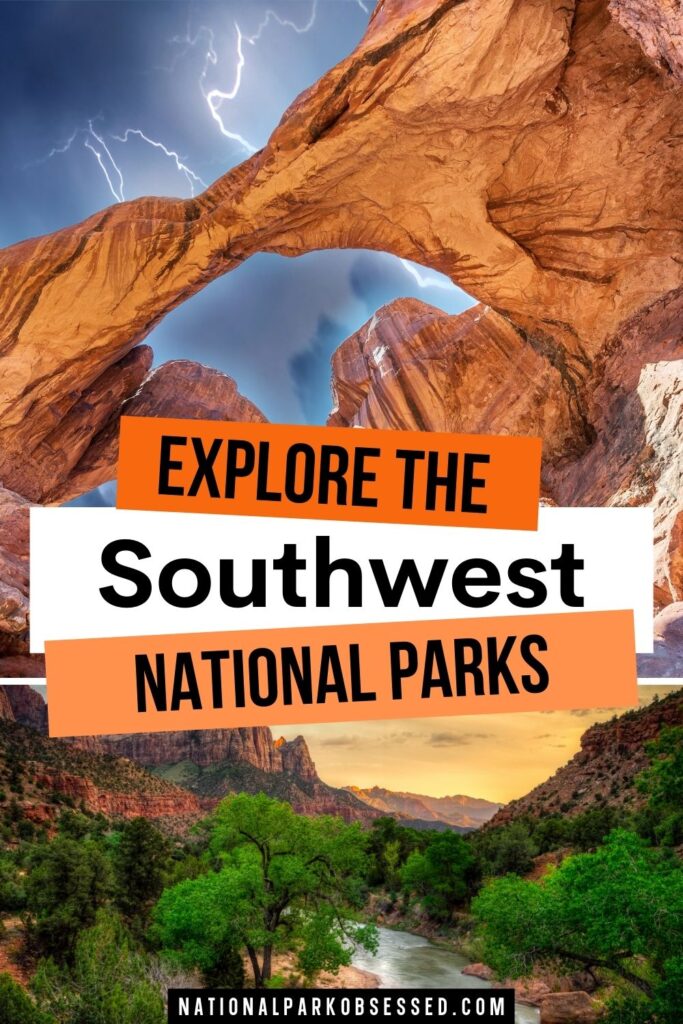
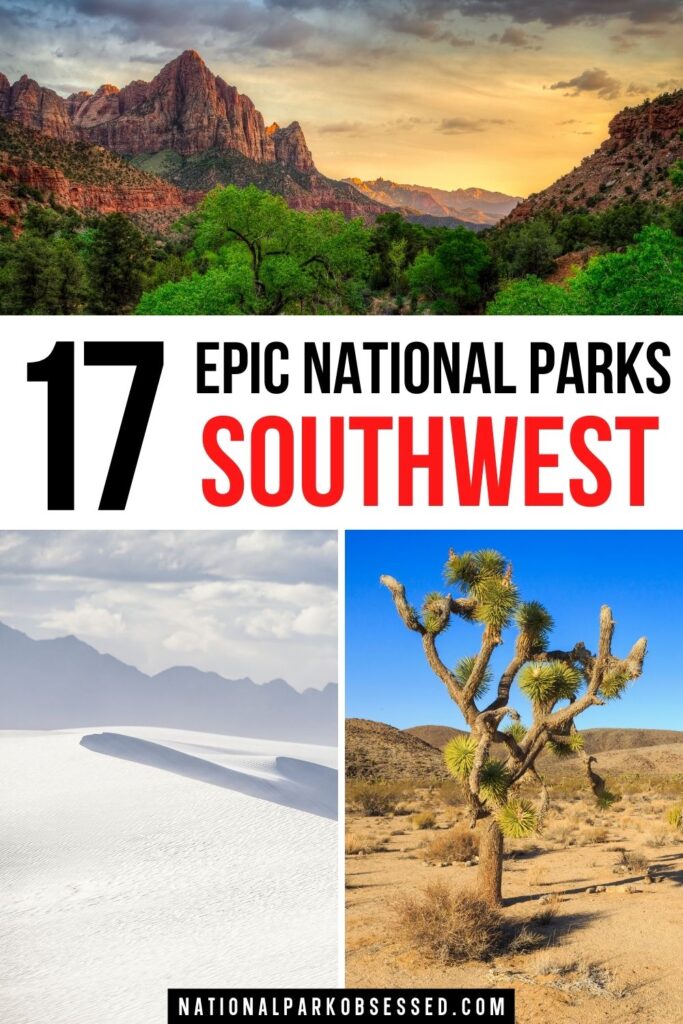
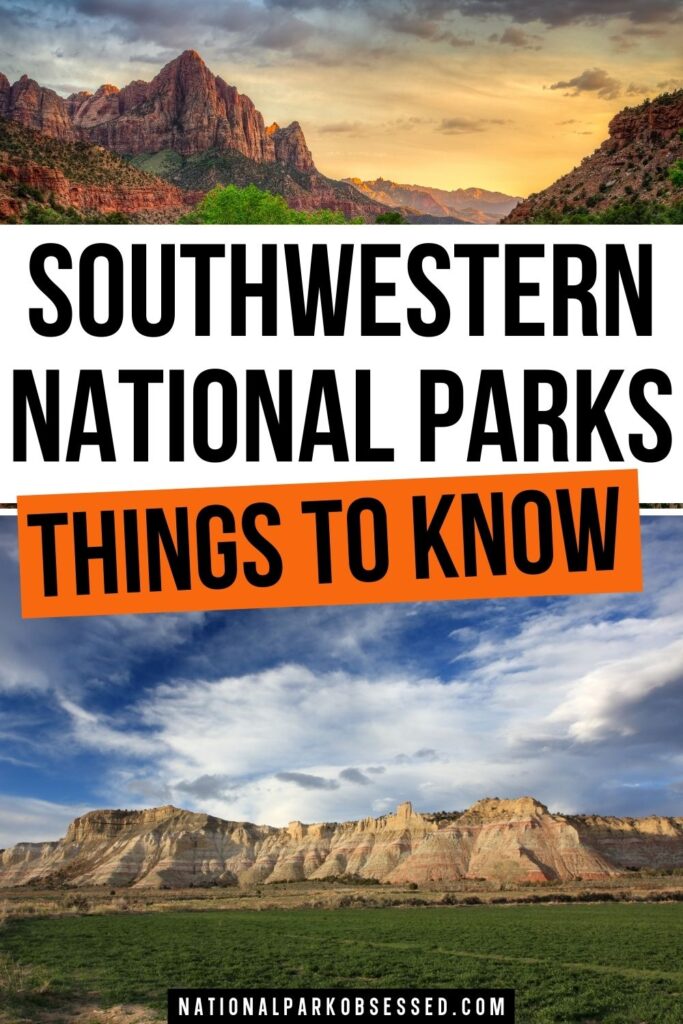
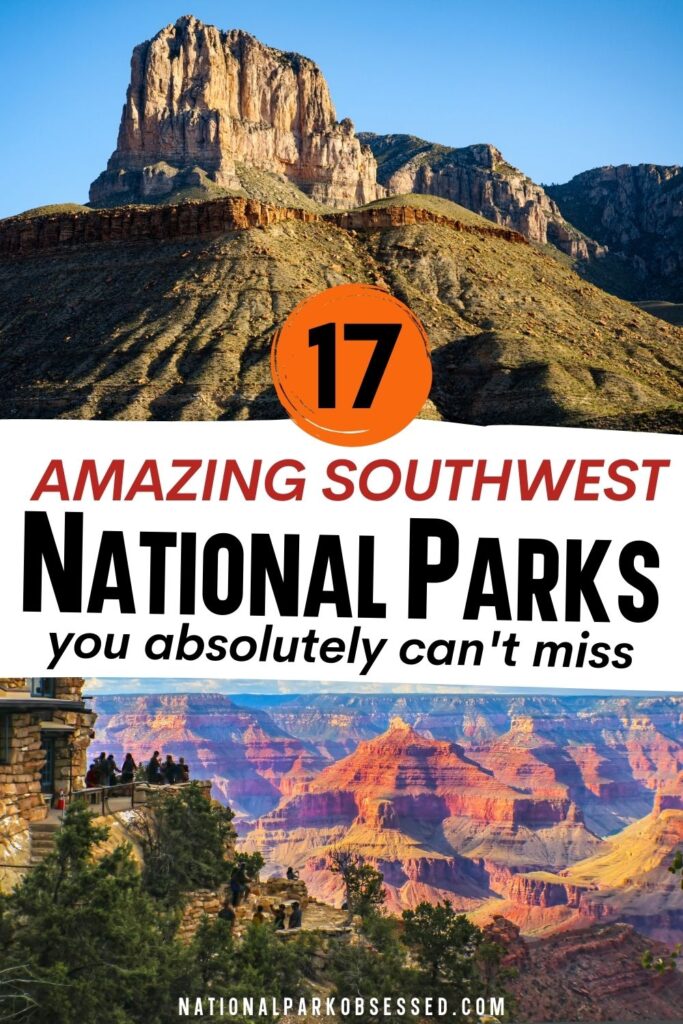

Post Summary: Southwestern National Parks
Famed for its impressive deserts and massive canyons, the American Southwest is home to some of the most impressive and iconic landscapes in the United States. The region’s landscape is dominated by four geographically distinct deserts -Great Basin, Mojave, Sonoran, and Chihuahuan each with their own diverse range of plant life. Beyond the deserts, the region is home to several small mountain ranges as well as several rivers and canyon systems. Inhabited for several thousand years, the landscape is dotted with ancestral dwellings and evidence of human inhabitation. There are 84 national parks in the Southwest to explore.
The article is a guide to the Southwestern National Parks including parks in the states of Arizona, New Mexico, Nevada, Texas, Utah, and parts of California and Colorado. We will cover:
- Tips on Visiting the Southwest National Parks
- Map of National Parks Southwest
- National Parks in the Southwest by State
- List of Southwest National Parks by Unit
- How many National Parks are in the Southwest?
- Tips on Visiting Southwest National Parks
- Map of the Southwest United States National Parks
- States of the Southwest
- National Parks of the Southwest by State
- List of the National Parks in the Southwest
- National Parks of the Southwest
- National Monuments of the Southwest
- National Preserves of the Southwest
- National Historical Parks of the Southwest
- National Historic Sites of the Southwest
- National Memorials of the Southwest
- National Recreation Areas of the Southwest
- National Seashores of the Southwest
- National Rivers of the Southwest
- Associated Units of the Northeast
- Final Thoughts on the Southwest National Parks
- Pin for Later: The Definitive List of National Parks in the Southwest (2021 Update)
This post may contain affiliate links, meaning if you book or buy something through one of these links, I may earn a small commission at no extra cost to you! Read the full disclosure policy here

How many National Parks are in the Southwest?
Defining the number of National Parks in the Southwest isn’t easy because it really depends on which states you consider to be part of the Southwestern United States For this list, we have defined the Southwest as Arizona, New Mexico, Nevada, Texas, Utah plus we have included the national parks of California and Colorado that we feel have the same flavor as the Southwestern National Parks. To that end, there are 17 National Parks in the Southwest.
If we want to talk about all the National Park Service units in the Southwest, there are 84 national parks in the Southwest. They are divided as follows
- 17 National Parks
- 38 National Monuments
- 4 National Preserves
- 8 National Historical Parks
- 8 National Historic Sites
- 1 National Memorial
- 6 National Recreation Areas
- 1 National Seashore
- 1 National River
Tips on Visiting Southwest National Parks
Best Time to Visit the National Parks in the Southwest
The National Parks of the Southwest are a mixture of desert, mountain/desert, and canyon parks. Most of these parks are best visited during the spring and fall. The temperatures during the spring and fall are milder and most of the parks are open.
Summer is a popular time to visit many of these parks. This is due to the fact that the kids are off from school and it is a great time to go camping and road trips. Some parks are better summer options than others. If you do plan to visit during the summer plan your activities for the morning or late afternoon to try to avoid the heat. Carry enough water.
National Parks vs National Parks Units
I’m going to get into a bit of technical semantics. So feel free to skip if you just don’t care and just want to get straight into the National Parks of the Southwest.
The National Park System is made of 423 units that are administrated by the National Park Service. They have a range of designations from “National Historical Park” to “National Seashore” to “National Park” In total there are 19 designations plus a few oddballs. National Park Service considers each of these units to be a national park.
When most people talk about visiting the National Parks, they mean the 63 units that hold the designation “National Park.” These 63 National Parks are the creme of the crop parks (or they are supposed to be but that is getting off-topic). These are typically the big outdoor-focused parks that are worth a 3-5 day visit.
Most people who are National Park Obsessed are usually working on the list of 63 and visiting the other 360 national parks when they are in the area. Some people do have the goal of visiting all 423 which is great but that is so much more work than just visiting 63. Personally, I’m almost done with the 63 and will probably keep working towards the 423 but I really hate visiting battlefields so it will take a lot longer to get motivated to visit them. I lived in Richmond, VA for two years. It took me 18 months to drag myself over to visit the Richmond National Battlefield Park.
If you want a more detailed explanation of the difference between a National Park and a national park unit click here.
How much does it cost to visit a Southwestern National Park? – National Park Fees & Passes
Most of the National Parks in the Southwest charge an entrance fee. It is usually $35 per vehicle for a 7-day pass. Looking at the other 67 national park units in the Southwest, it is hit or miss whether the park charges an entrance free. Only about a quarter of the park in the park system charge an entrance fee.
If you are planning to explore more than two National Parks or 3-5 other designations in a year, you should plan on getting an America the Beautiful Pass. The pass is $80 and you get unlimited access to all entrance fee-charging in National Parks along with more than 3,000 other federal lands.
Both Grand Canyon and Zion charge a $35 entrance fee. That is $70 in entrance fees right there. Throw another park in and you have just saved $25 in entrance fees.
>>> You can get the America the Beautiful Pass from REI.
Fee Free Days in 2022
If you don’t plan (or can’t afford to) on purchasing an Ameria the Beautiful Annual Pass, there are six fee-free days each year. You can access the entrance fee-charging national parks for free on these days. Even if you have the Annual Pass, Fee Free Days can be a great time to visit the parks. Many parks have special activities on these days.
- January 17: Birthday of Martin Luther King, Jr.
- April 16: First day of National Park Week
- August 4: One year anniversary of the Great American Outdoors Act
- September 24: National Public Lands Day
- November 11: Veterans Day
Map of the Southwest United States National Parks
States of the Southwest
National Parks of the Southwest by State
Arizona
Arizona has three units holding the title of National Park.
Grand Canyon National Park
Grand Canyon National Park is home to one of the world’s largest and most impressive canyons. The canyon is over 277 miles long and up to 18 miles wide and over a mile deep. This popular national park attracts visitors from all over the world. There is amazing hiking both above and below the canyon rim. The endangered California Condors are often found flying along the canyon rim.
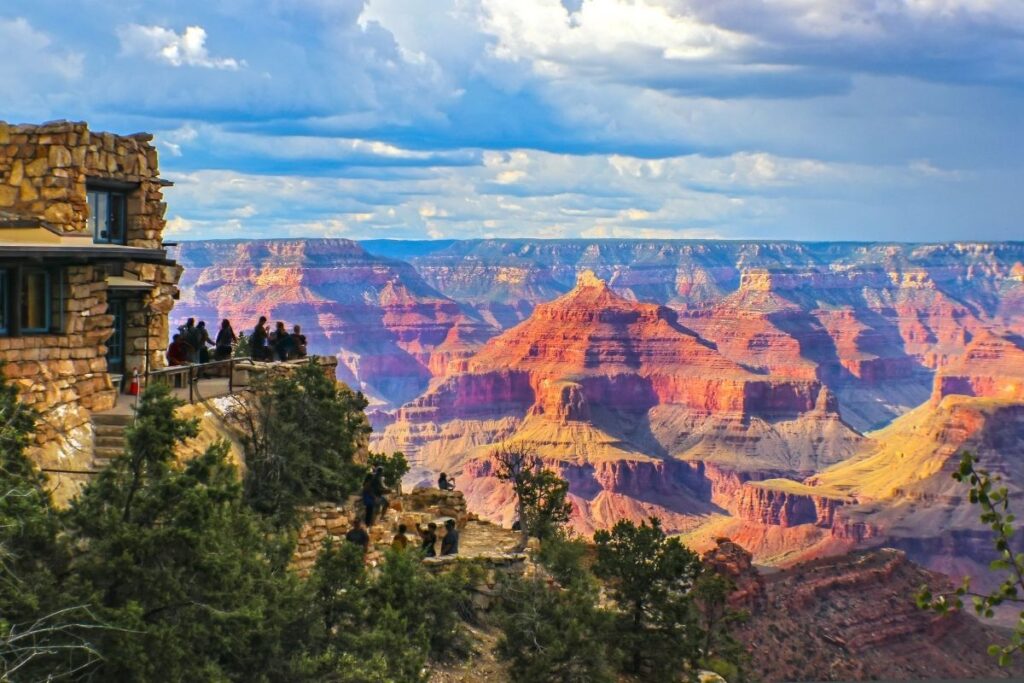
Petrified Forest National Park
Petrified Forest National Park protects a large deposit of petrified wood and a series of colorful badlands called the Painted Desert. The petrified wood is from the Late Triassic Epoch and is a colorful record of plants that once lived in the region. The park is home to more than 600 archeological sites including petroglyphs and pit houses.
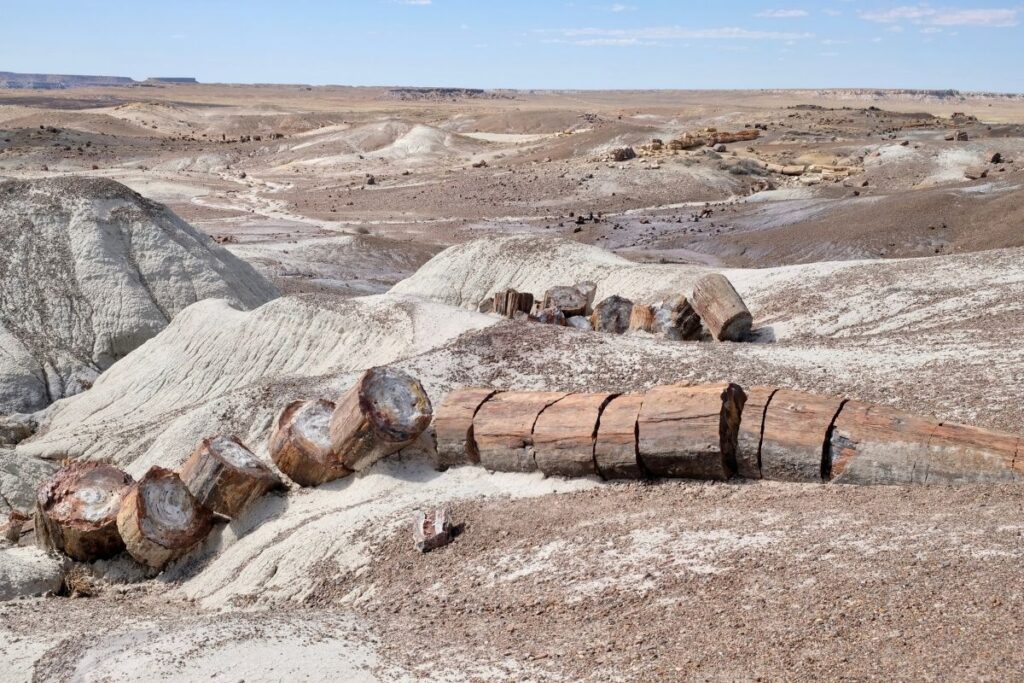
Saguaro National Park
Saguaro National Park is a desert national park famed for its Saguaro cacti. The park is made up of two districts with slightly different landscapes. Each district is dominated by a mountain range. The Rincon Mountain District is dominated by the Rincon Mountains which are higher and wetter than the Tuscon Mountains of the Tuscon Mountain District.
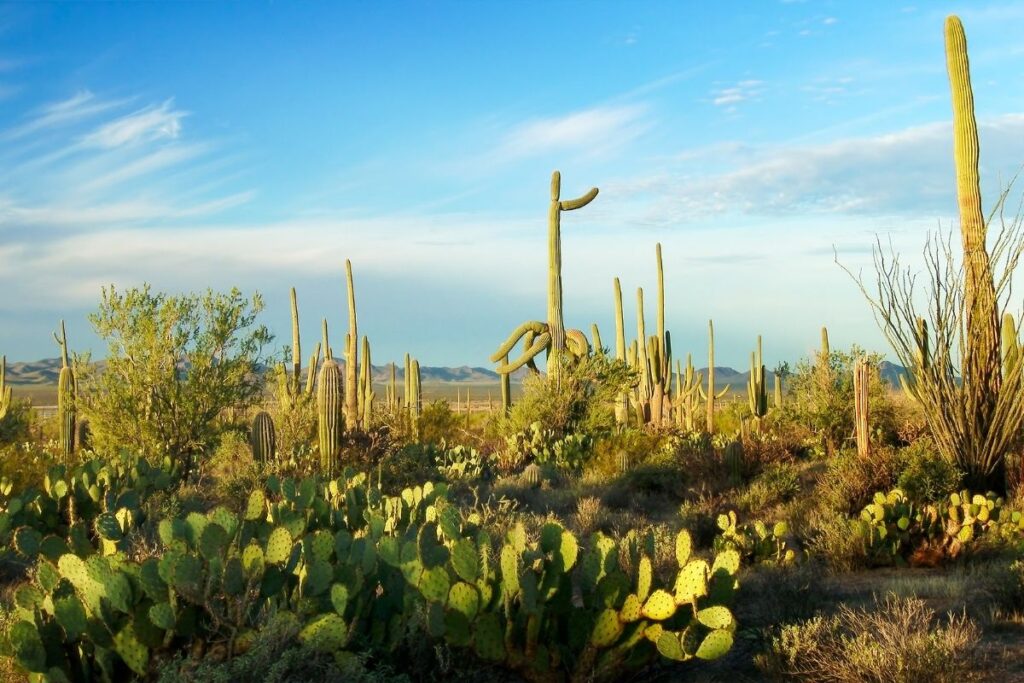
Other National Park Units in Arizona
Here are the nineteen other National Park units in Arizona.
- Canyon De Chelly National Monument
- Casa Grande Ruins National Monument
- Chiricahua National Monument
- Coronado National Memorial
- Fort Bowie National Historic Site
- Glen Canyon National Recreation Area (AZ, UT)
- Hohokam Pima National Monument
- Hubbell Trading Post National Historic Site
- Lake Mead National Recreation Area (AZ, NV)
- Montezuma Castle National Monument
- Navajo National Monument
- Organ Pipe Cactus National Monument
- Pipe Spring National Monument
- Sunset Crater Volcano National Monument
- Tonto National Monument
- Tumacacori National Historical Park
- Tuzigoot National Monument
- Walnut Canyon National Monument
- Wupatki National Monument
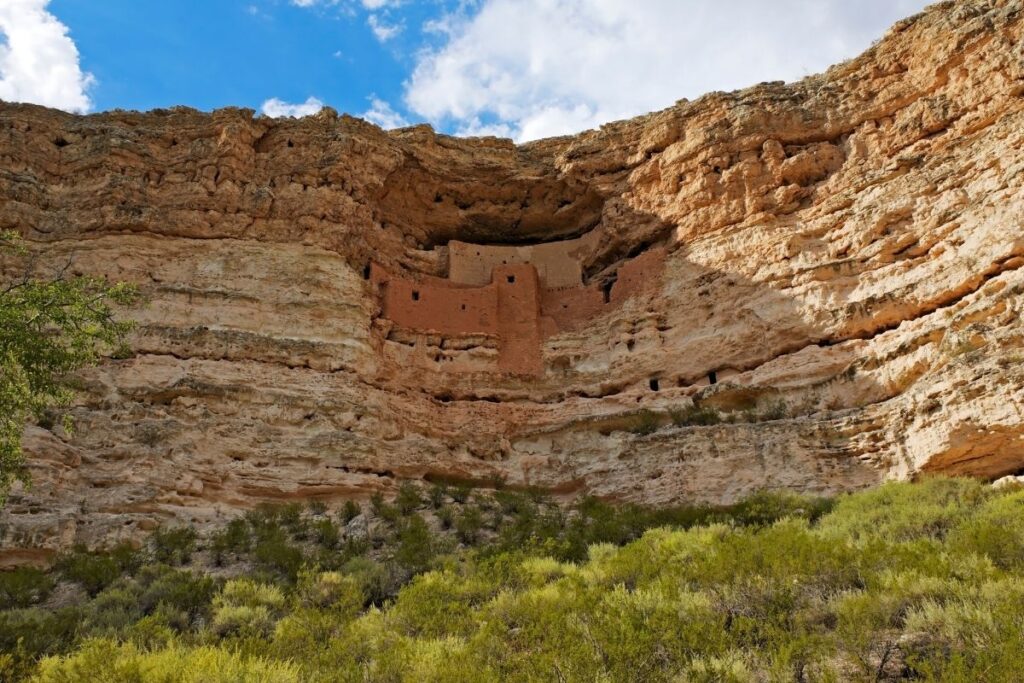
California
Death Valley National Park
Death Valley National Park is the largest National Park in the lower 48. The park is located primarily in California with a small site located in Nevada (see Death Valley’s listing under Nevada to learn more). This desert national park holds a lot of records. It is the hottest, driest, and lowest place in the United States. It also holds the record for the hottest temperature ever recorded. The park occupies a zone in between the Great Basin and Mojave Deserts. This transition zone gives the park a unique landscape with some amazing features.
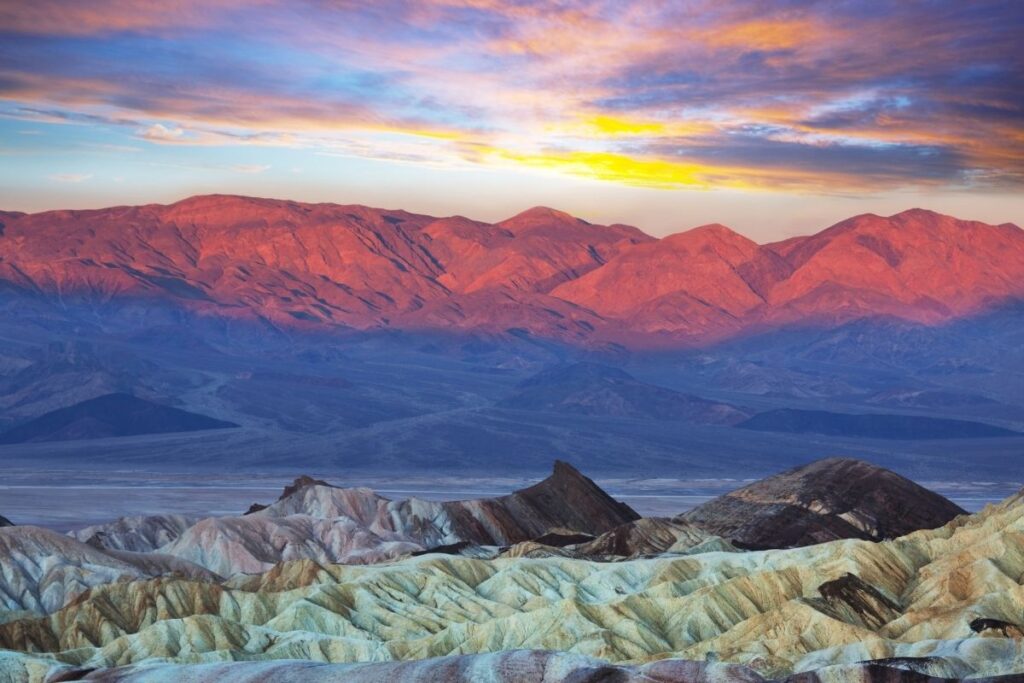
Joshua Tree National Park
Joshua Tree National Park sits at the divide of the Colorado Desert and the Mojave Desert. The park is famed for its Joshua Trees (Yucca brevifolia). While called a tree, Joshua Trees are actually a tree-like yucca plant. These plants dominate the park’s Mojave Desert region. In addition to the desert plants, the park is home to a couple of small mountain ranges with some amazing rock formations.
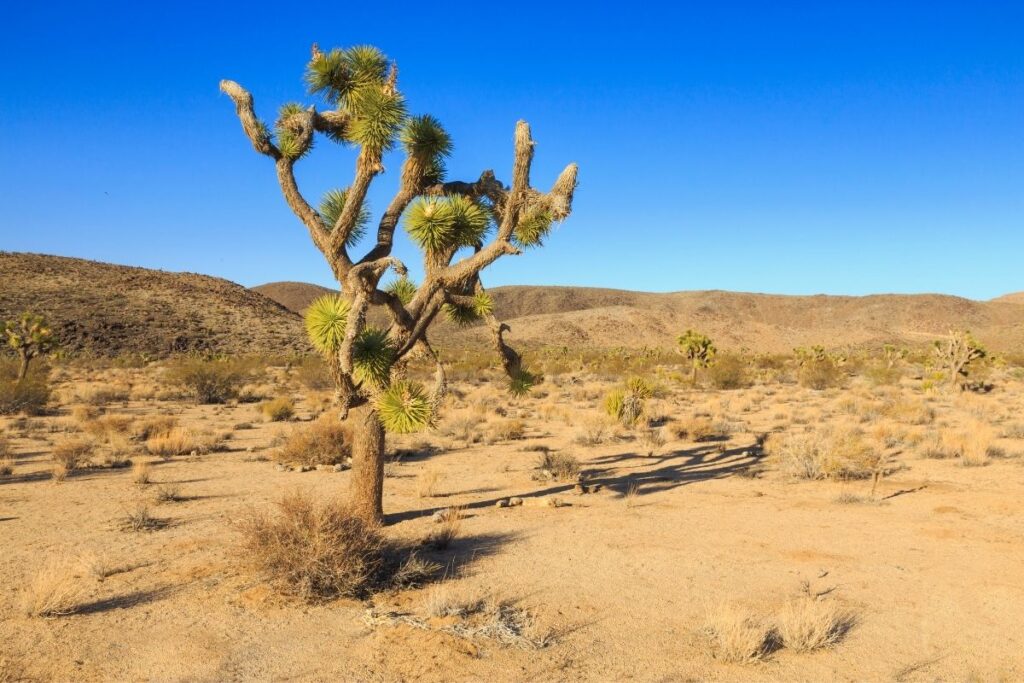
Other Southwestern National Park Units in California
Here are the six southwestern units along with twenty other National Park units in California.
- Cabrillo National Monument
- Castle Mountains National Monument
- Mojave National Preserve
- Manzanar National Historic Site
- César E. Chávez National Monument
- Santa Monica Mountains National Recreation Area
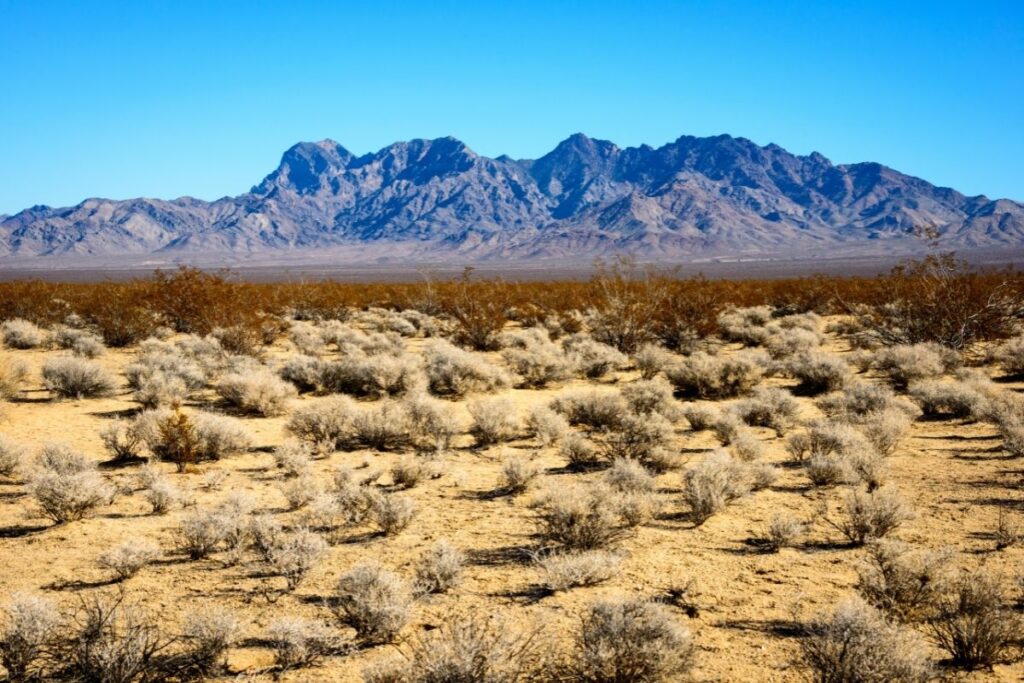
Other Units in California Not Consider to be part of the Southwest
- Channel Islands National Park
- Devils Postpile National Monument
- Eugene O’Neill National Historic Site
- Fort Point National Historic Site
- Golden Gate National Recreation AreaAlcatraz Island
- John Muir National Historic Site
- Kings Canyon National Park
- Lassen Volcanic National Park
- Lava Beds National Monument
- Muir Woods National Monument
- Pinnacles National Park
- Point Reyes National Seashore
- Port Chicago Naval Magazine National Memorial
- Redwood National Park and State Parks
- Rosie the Riveter/World War II Home Front National Historical Park
- San Francisco Maritime National Historical Park
- Sequoia National Park
- Tule Lake National Monument
- Whiskeytown-Shasta-Trinity National Recreation Area
- Yosemite National Park
Colorado
Connecticut doesn’t have any National Parks. While there are other national parks in the state, none of them hold the title “National Park.”
Black Canyon of the Gunnison National Park
Black Canyon of the Gunnison National Park is an underrated canyon national park. The dramatic canyon features steep canyon walls which make it hard for light to showcase the rock’s natural color giving this canyon a blackish color and its name. This canyon is one of the steepest canyons in North America. The Gunnison River drops an average of 34 ft per mile and has carved this canyon over millions of years.
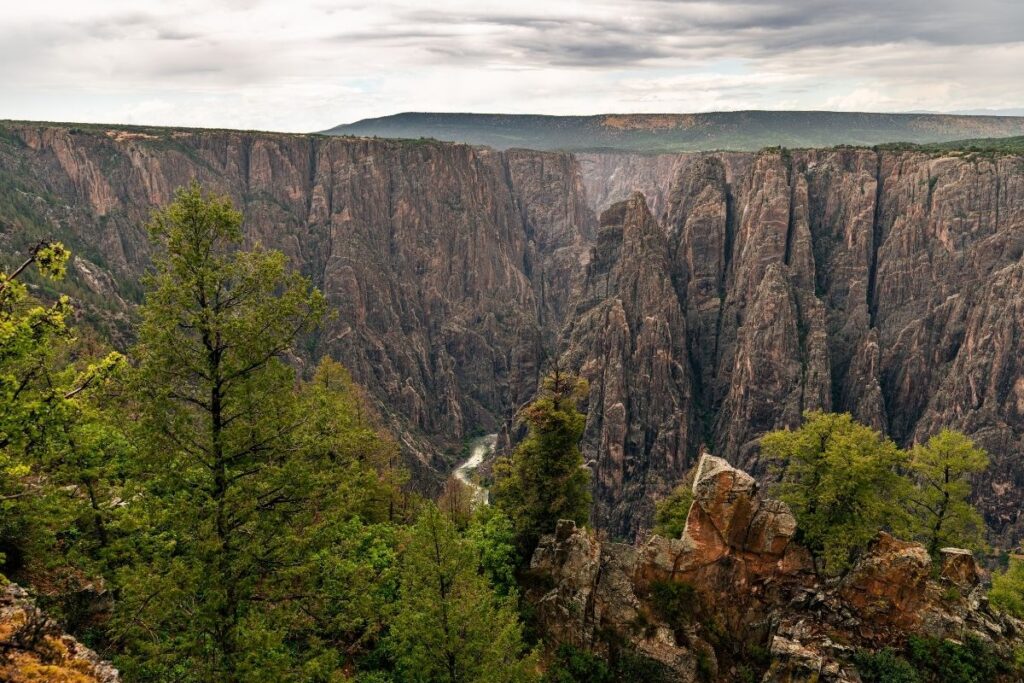
Great Sand Dunes National Park and Preserve
Great Sand Dunes National Park and Preserve protects the tallest sand dunes in North American. It is estimated that there are about 1.2 cubic miles of sand. This park is actually two National Park Service units – Great Sand Dunes National Park and Great Sand Dunes National Peserve. The two units are managed as a single park. While Great Sand Dunes is primarily known for its sand, the park includes alpine tundra, subalpine forests, and montane woods as well as part of the Sangre de Cristos Range.
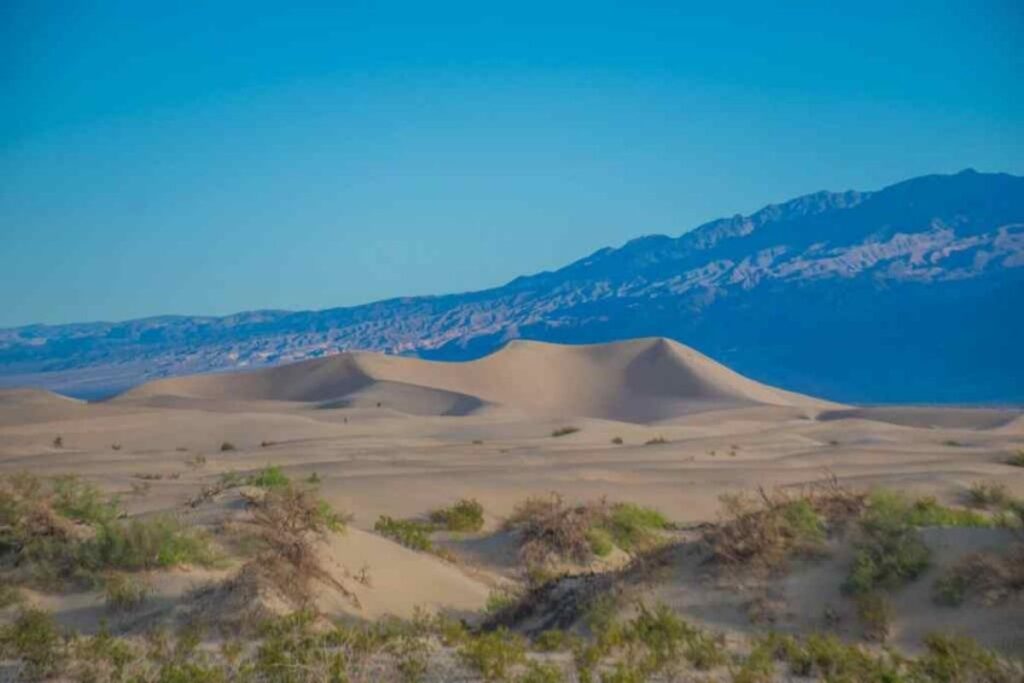
Mesa Verde National Park
Mesa Verde National Park is a UNESCO World Heritage Site and home to some of the best-preserved Ancestral Puebloan archeological sites. There are more than 5,000 archeological sites including more than 600 cliff dwellings within the park. The most impressive of which is Cliff Palace. Cliff Palace has 150 rooms and is though to have been home to a population of 100 people.
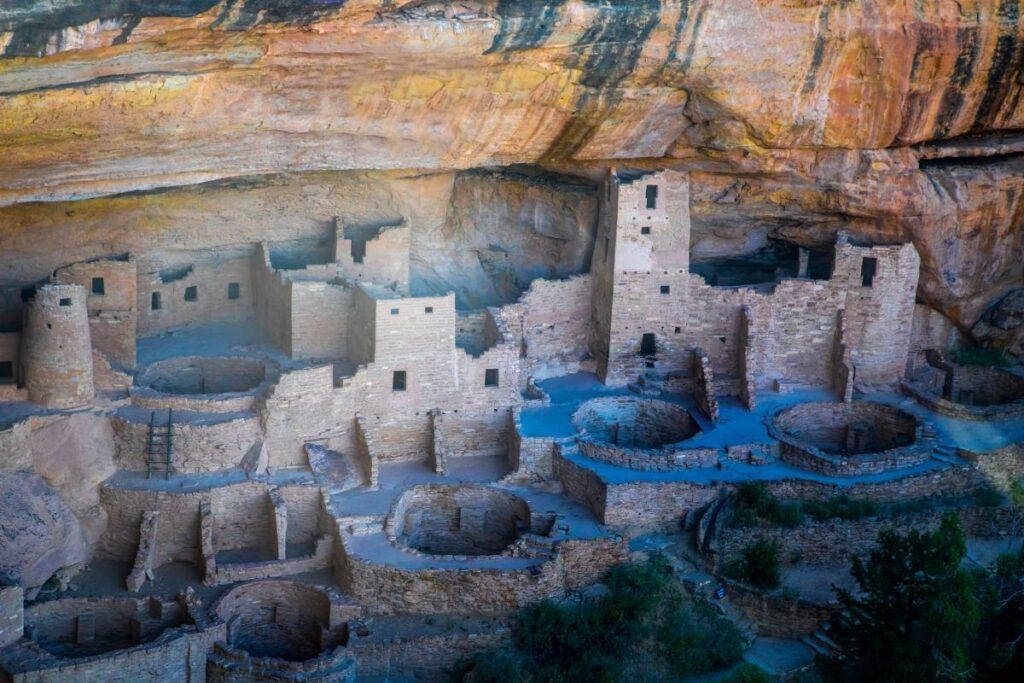
Other National Park Units in Colorado
Here are the eight other National Park units in Colorado.
- Bent’s Old Fort National Historic Site
- Colorado National Monument
- Curecanti National Recreation Area
- Dinosaur National Monument (CO, UT)
- Florissant Fossil Beds National Monument
- Hovenweep National Monument (CO, UT)
- Sand Creek Massacre National Historic Site
- Yucca House National Monument
Rocky Mountain National Park is located in Colorado but isn’t consider to be a National Park of the Southwest so it is not included on this list.
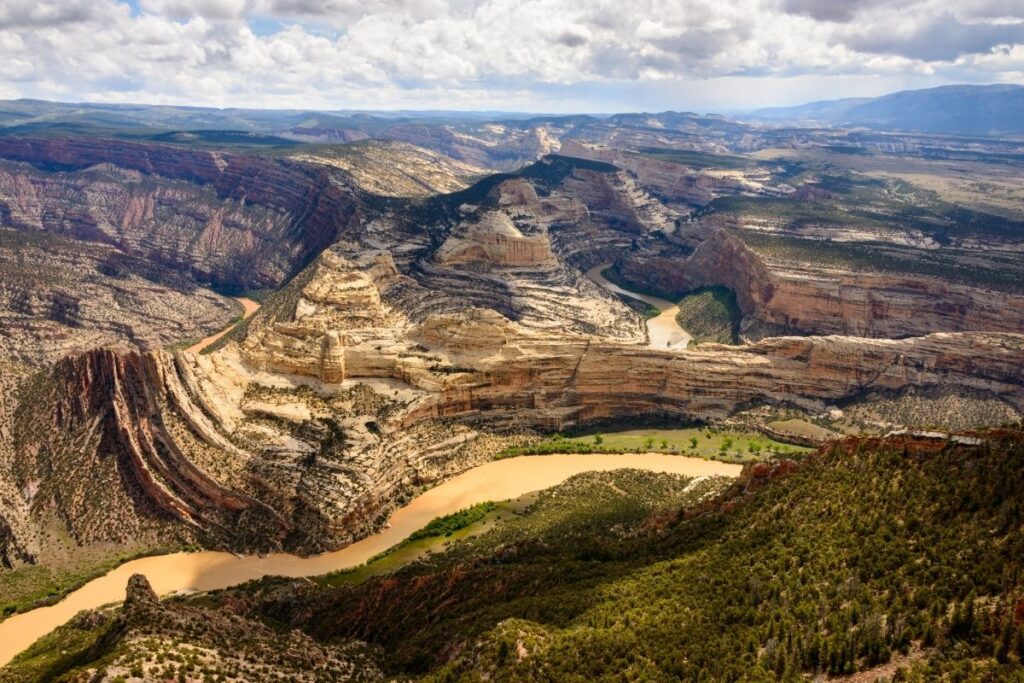
Nevada
Death Valley National Park
The main portion of Death Valley National Park is located in California but a detached unit of Death Valley is located in Ash Meadows National Wildlife Refuge. This small hole in the ground is a geothermal pool in a limestone cavern. This spot known as Devils Hole is the only natural habitat of the Devils Hole pupfish. These pupfish are critically endangered and have a population of fewer than 200 individuals. Visitors to Devils Hole are limited to a caged structure above the hole but it is worth a quick visit to check out the area.
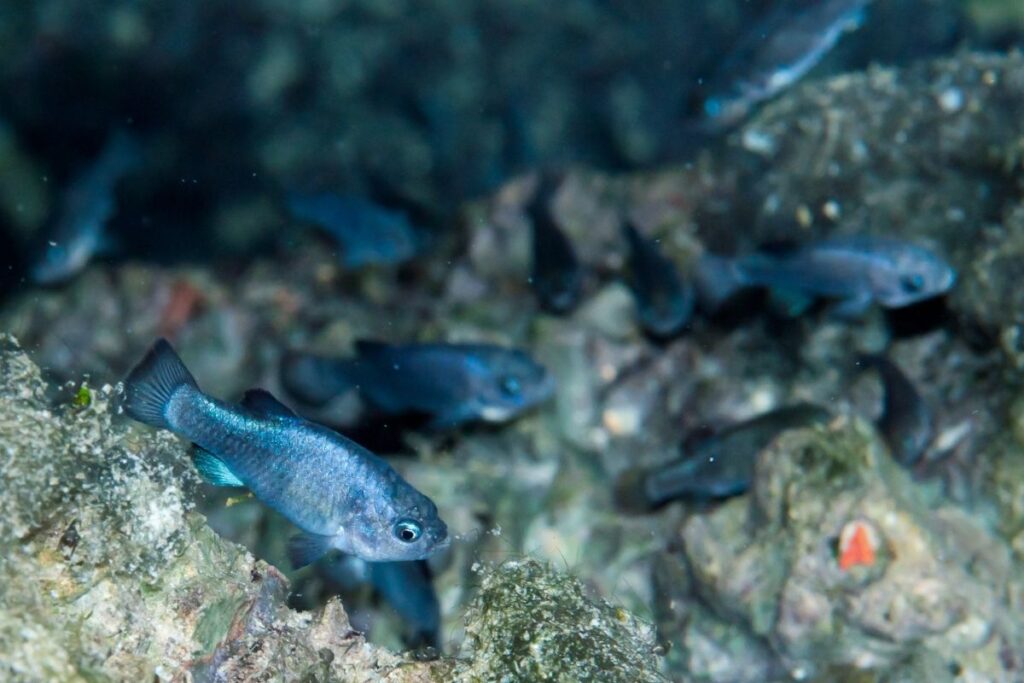
Great Basin National Park
Great Basin National Park is home to the Bristlecone Pines. One of the Bristlecone Pines was at least 5,000 years old and the oldest known oldest nonclonal organism at the time it was cut down for research purposes in the 1960s. Besides the Bristlecone Pines, the park is known for Lehman Caves and Wheeler Peak.
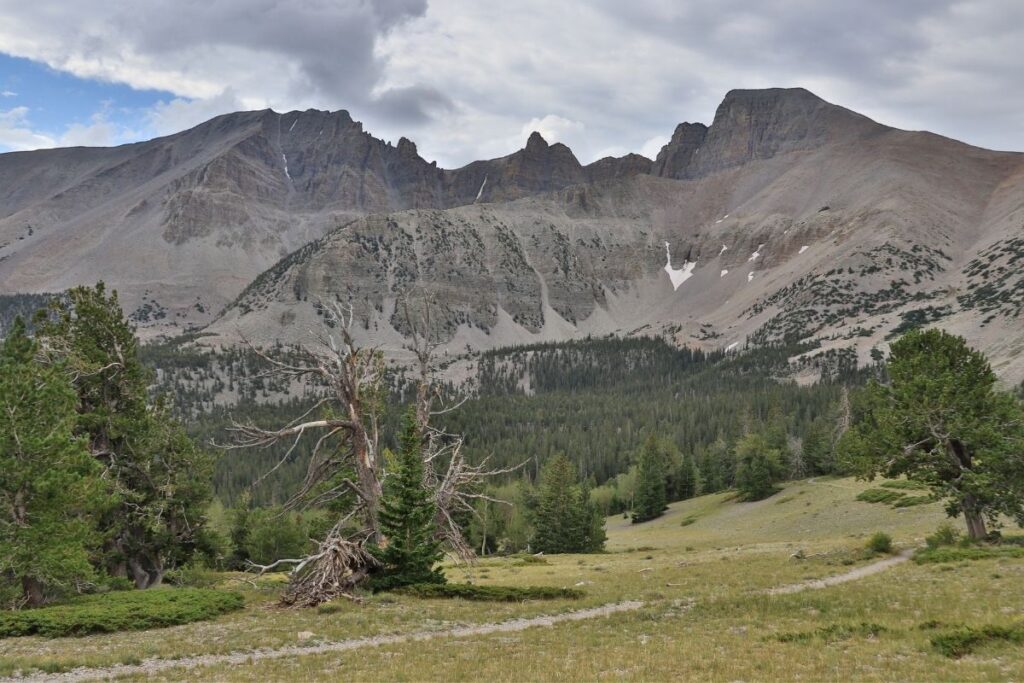
Other National Park Units in Nevada
Here are the two other National Park units in Nevada.
- Lake Mead National Recreation Area
- Tule Springs Fossil Beds National Monument
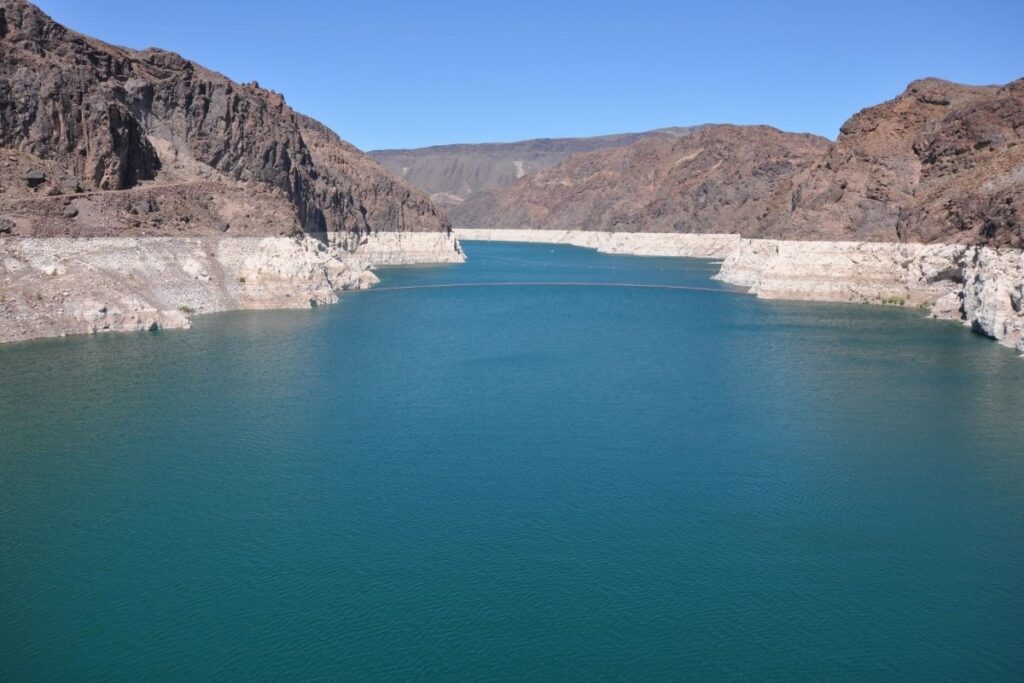
New Mexico
Carlsbad Caverns National Park
Carlsbad Caverns National Park is a limestone cave located in the Guadalupe Mountains. Carlsbad Caverns is full of cave formations such as stalactities, stalagmites, columns, soad straws, draperies and popcorn. The cave is a UNESCO World Heritage Site. There are two entrance to the cave. The first is the natural entrance which visitors can walk down. The second is the elevator. There are many named rooms in the cave, some accessible to the public, some not. The largest room in the cave is the Big Room and is almost 4,000 ft long and 625 ft wide and 255 ft high.
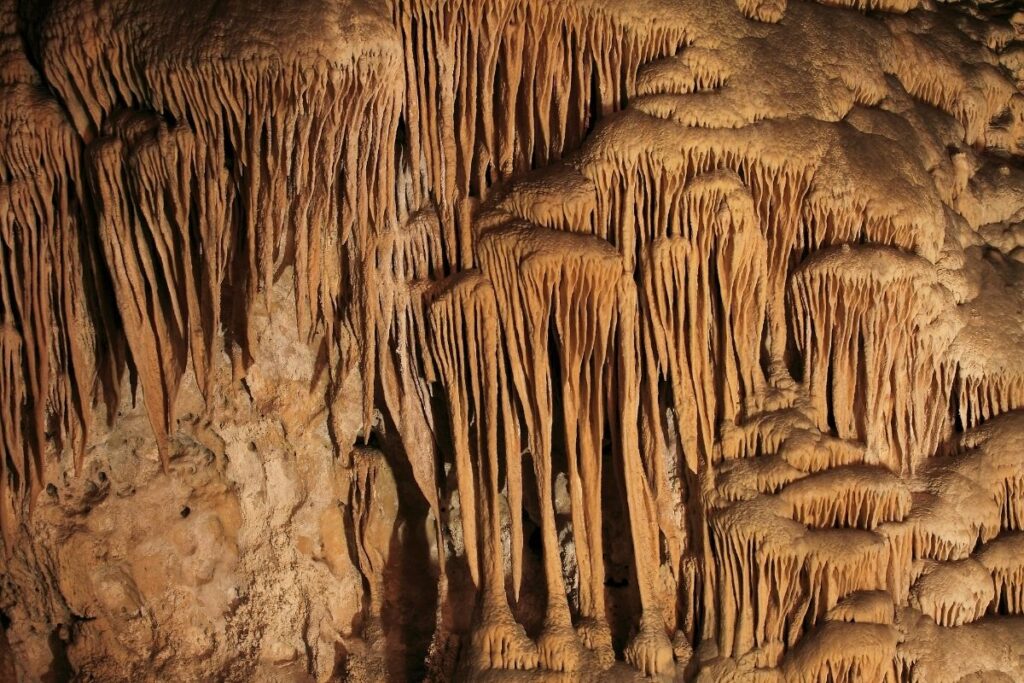
White Sands National Park
White Sands National Park is a gypsum dunefield in the Tularosa Basin. The gypsum gives the dunes their white color. The dunefield contains carious types of dunes such as transverse, barchan and paradbolic dunes. Visitors to the dunes can hike, sled and explore these amazing dunes.
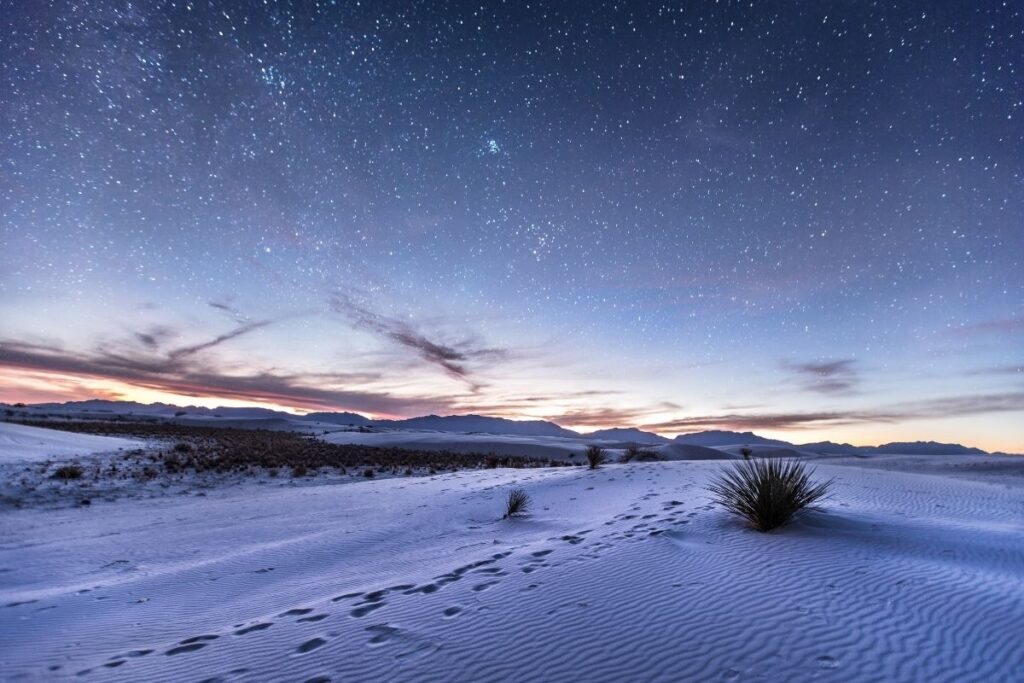
Other National Park Units in New Mexico
Here are the thirteen other National Park units in New Mexico.
- Aztec Ruins National Monument
- Bandelier National Monument
- Capulin Volcano National Monument
- Chaco Culture National Historical Park
- El Malpais National Monument
- El Morro National Monument
- Fort Union National Monument
- Gila Cliff Dwellings National Monument
- Manhattan Project National Historical Park
- Pecos National Historical Park
- Petroglyph National Monument
- Salinas Pueblo Missions National Monument
- Valles Caldera National Preserve
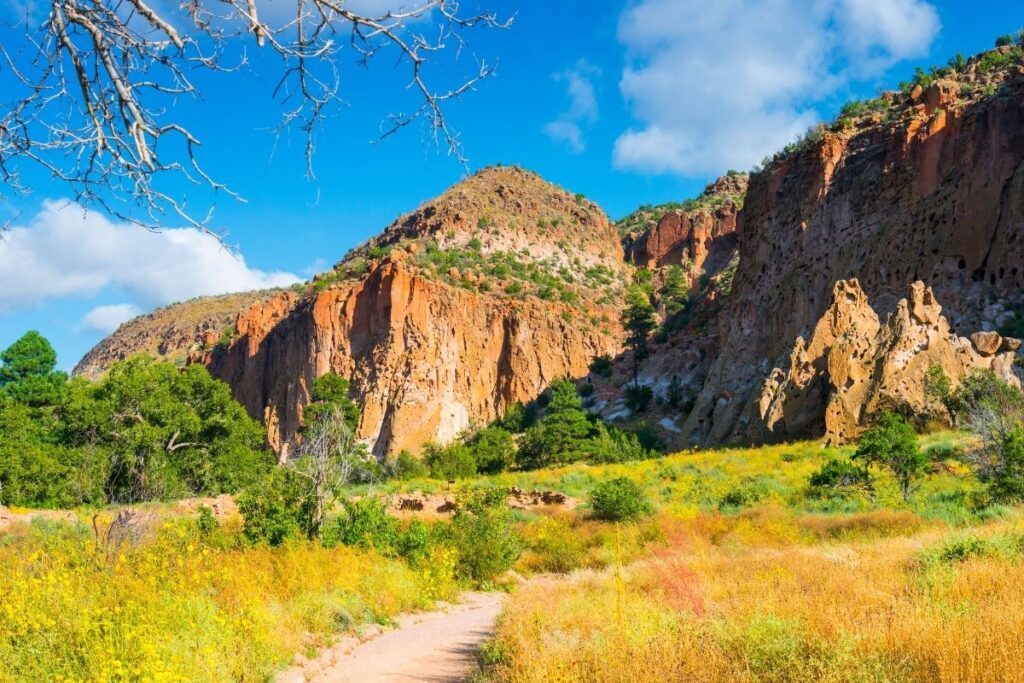
Oklahoma
Oklahoma doesn’t have any National Parks. While there are other national parks in the state, none of them hold the title “National Park.”
Other National Park Units in Oklahoma
Here are the three other National Park units in Oklahoma.
- Chickasaw National Recreation Area
- Fort Smith National Historic Site
- Washita Battlefield National Historic Site
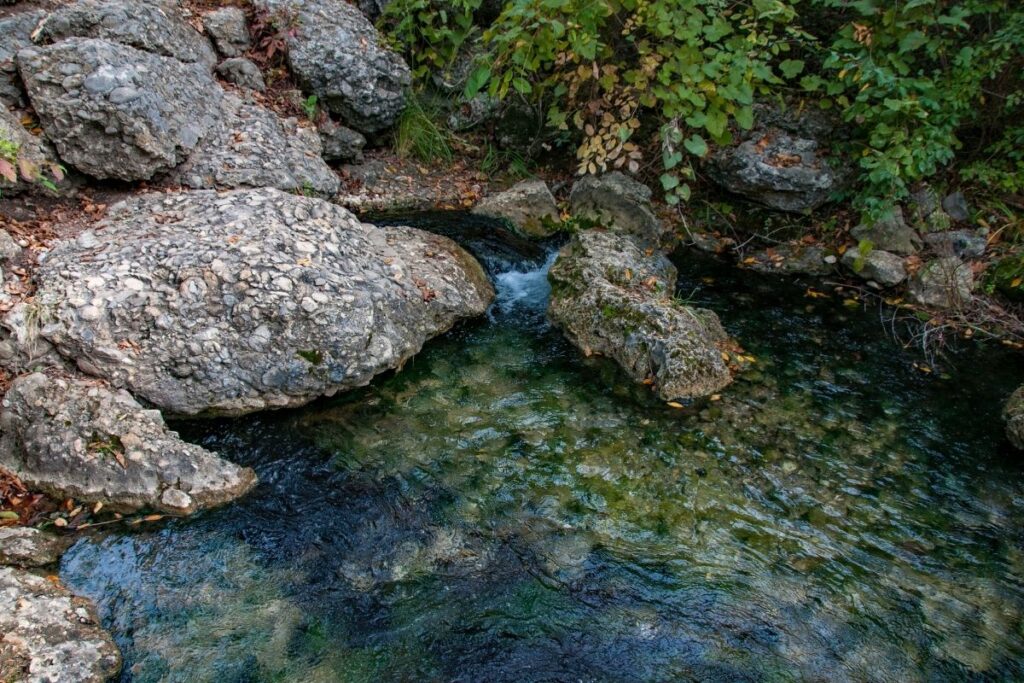
Texas
Big Bend National Park
Big Bend National Park is located in southern Texas along the Mexico border in the large bend in the Rio Grande River. The park protects the Chisos Mountains and the Chihuahaun Desert. The Chisos are the only mountain range located enterially within a National Park. The park is best know for the Santa Elena Canyon in which the Rio Grande runs through the river. The park is an International Dark Sky Park.
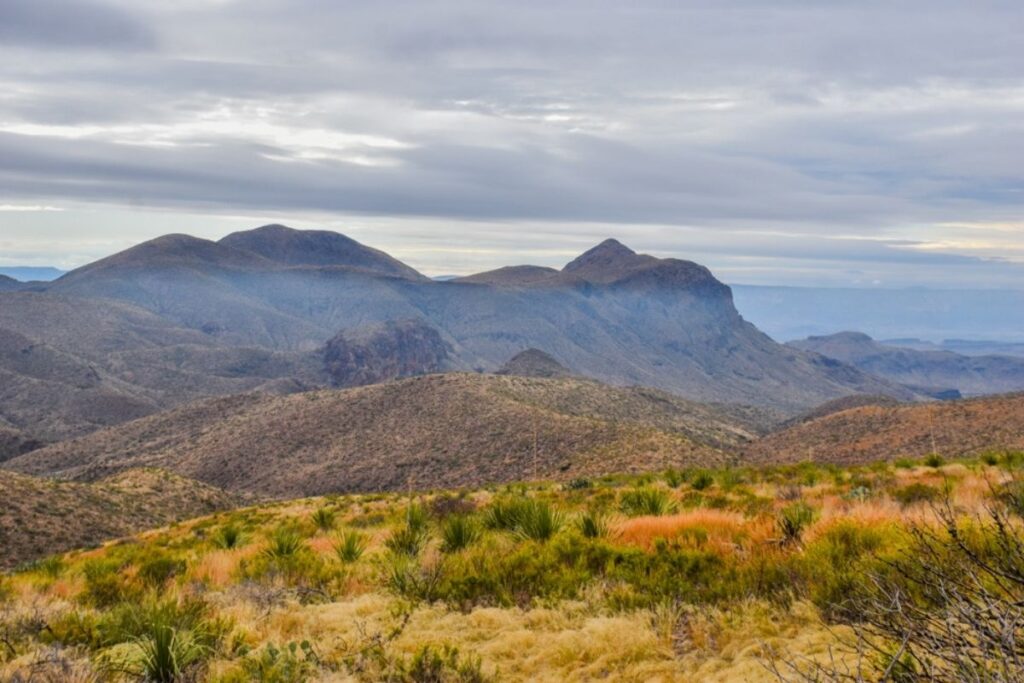
Guadalupe Mountains National Park
Guadalupe Mountains National Park protects part of the Guadalupe Mountains in western Texas. The park includes Guadalupe Peak which is the highest point in Texas and El Capitain, which is a landmark on the Butterfield Overland Main Stagecoach line. The park is a hiker’s dream land. There are a limited number of roads in the park and most of the park is only accessible by foot.
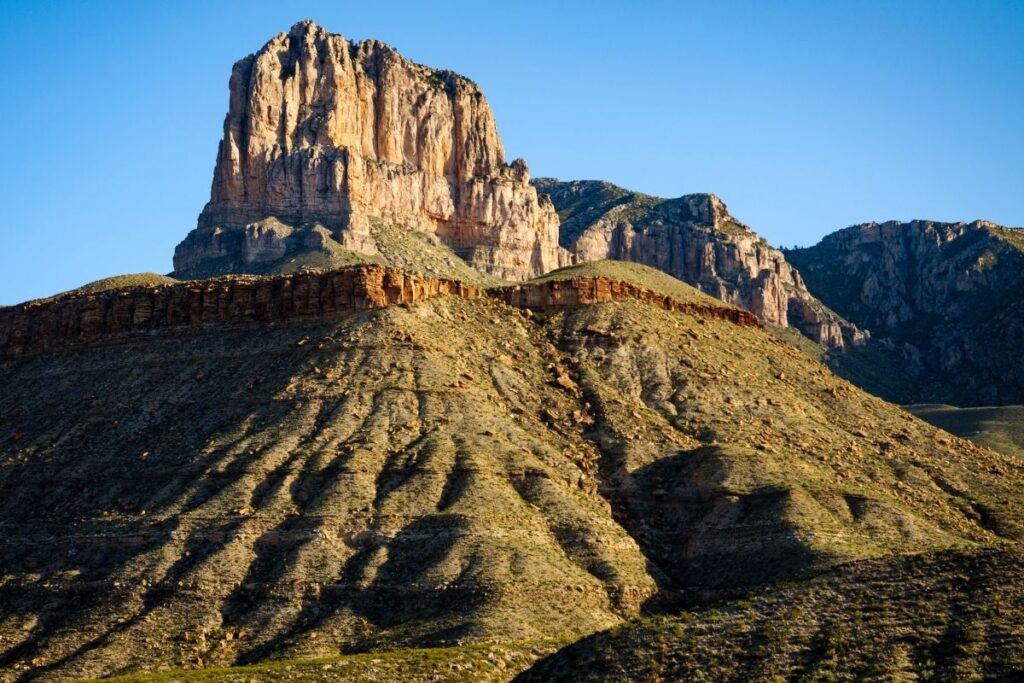
Other National Park Units in Texas
Here are the twelve other National Park units in Texas.
- Alibates Flint Quarries National Monument
- Amistad National Recreation Area
- Big Thicket National Preserve
- Chamizal National Memorial
- Fort Davis National Historic Site
- Lake Meredith National Recreation Area
- Lyndon B. Johnson National Historical Park
- Padre Island National Seashore
- Palo Alto Battlefield National Historical Park
- Rio Grande Wild and Scenic River
- San Antonio Missions National Historical Park
- Waco Mammoth National Monument
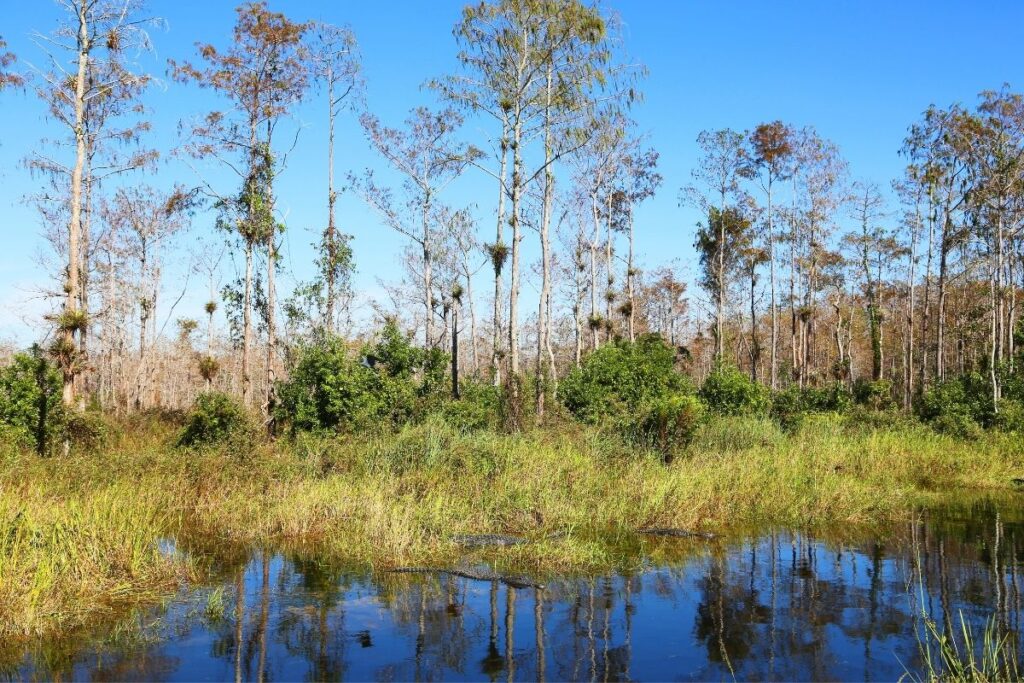
Utah
Arches National Park
Arches National Park gets its name from the more than 2,000 sandstone arches. The park has the highest density of natural arches in the world. The most famous arch is Delicate Arch. This famed arch is a 52 foot freeshaning arch and is depicted on Utah License plates. Many of the arches are a short hike from the park’s roads making them popular attractions and easily accessible for average hikers.
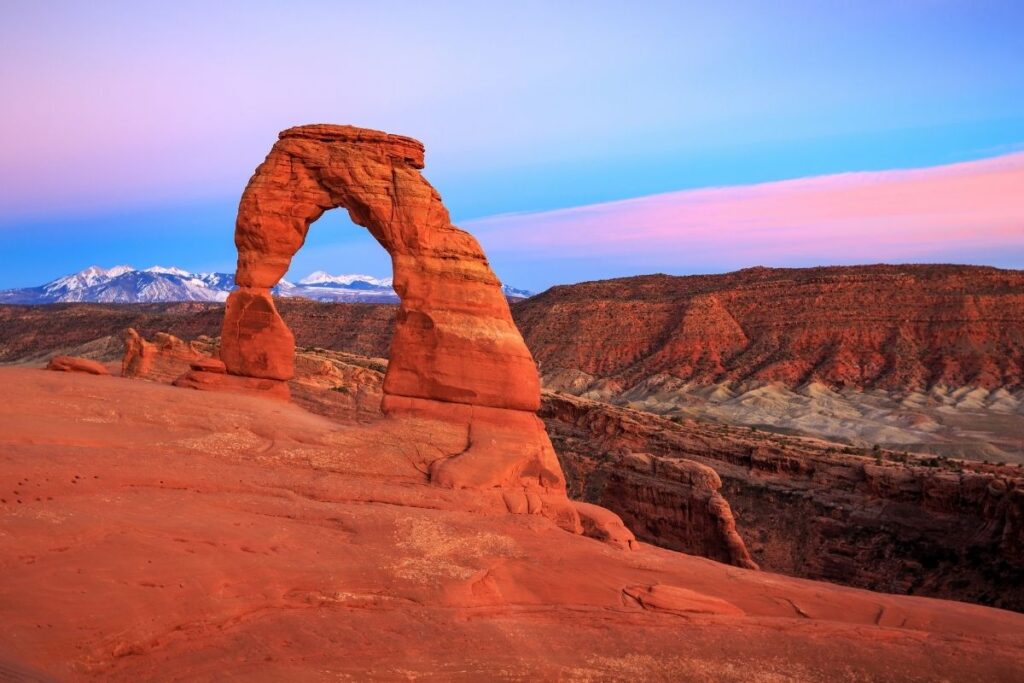
Bryce Canyon National Park
Bryce Canyon National Park is known for the natural amphitheatre full of a unique geological structure known as hoodoos. These hoodoos areformed by a compilation of erosion and frost weathering. The park has a higher elevation than the other Mighty Five National Park. The park is popular for its hiking trails and sunrises.
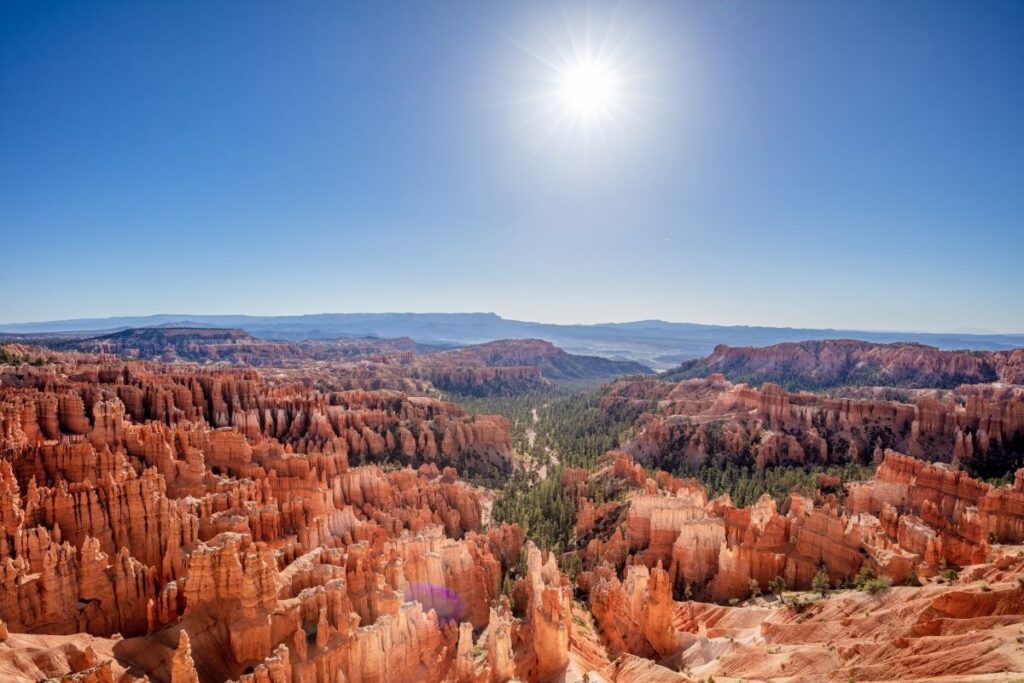
Canyonlands National Park
Canyonlands National Park is Arches sister park. Located just down the road from Arches, Canyonlands is a massive park with a different flair than arches. Arches got all the Arches and Canyonlands got the canyons. The Green and Colorado Rivers have carved massive canyons within the park and created a unique and otherworldly landscape. Canyonlands is made up of four regions – Island in the Sky, the Needles, the Maze, and the combined rivers. Isalnd in the Sky is a giant plateau that overlooks the rivers. The Needles is a popular backpacking and hiking area where hikers get to walk in between some intrestingly shaped rock formations. A 1-star review once referred to the Needles as “donkey d**ks”
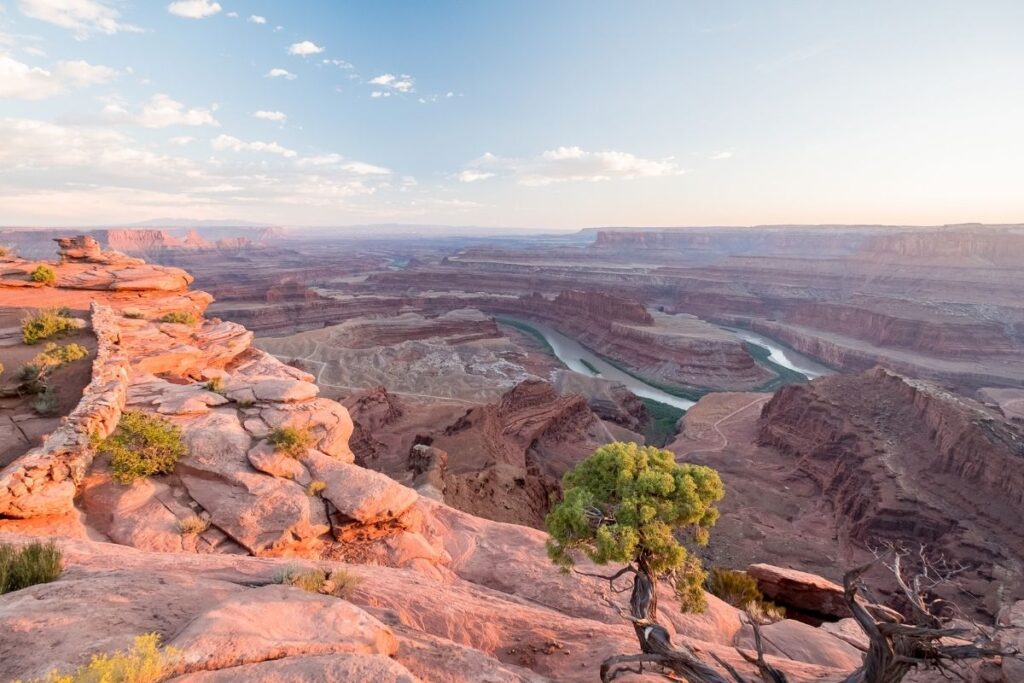
Capitol Reef National Park
Capitol Reef National Park is by Utah standards a lush national park. The park is known for a rock formation known as the Waterpocket Fold and Navajo Sandstone as well as its fruit trees. Capitol Reef’s landscape is a bit like if you took a bit of each of the other Utah National Parks and mixed them together and added fruit trees. The park has canyon, rock towers, domes, cliffs, arches. If you haven’t noticed, I mentioned fruit trees. The park is home to several different types of fruit orchards and when in season you are welcome to pick the fruit.
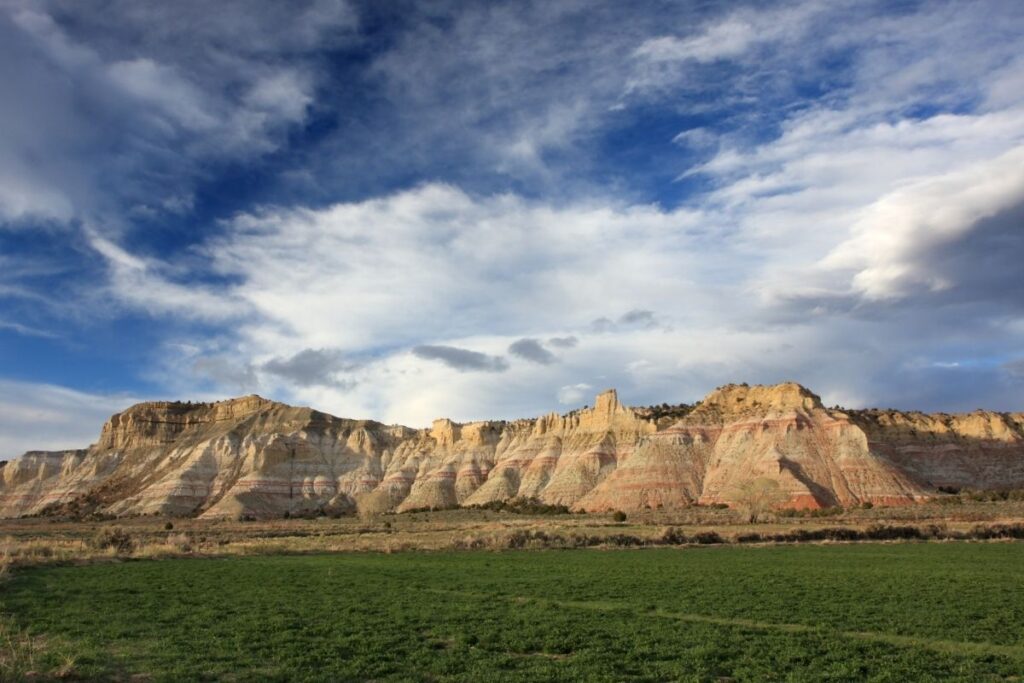
Zion National Park
Zion National Park is one of the most ICONIC national parks in the United States. The park is home to TWO bucket list hikes – Angels Landing and the Narrow. This spectacular canyon park was carved by the Virgin River out of Navajo Sandstone. The park located the junction of the Colorado Plateau, Great Basin, and Mojave Desert regions. The park has a range of lifestones and a highly diverse range of plant and animal species.
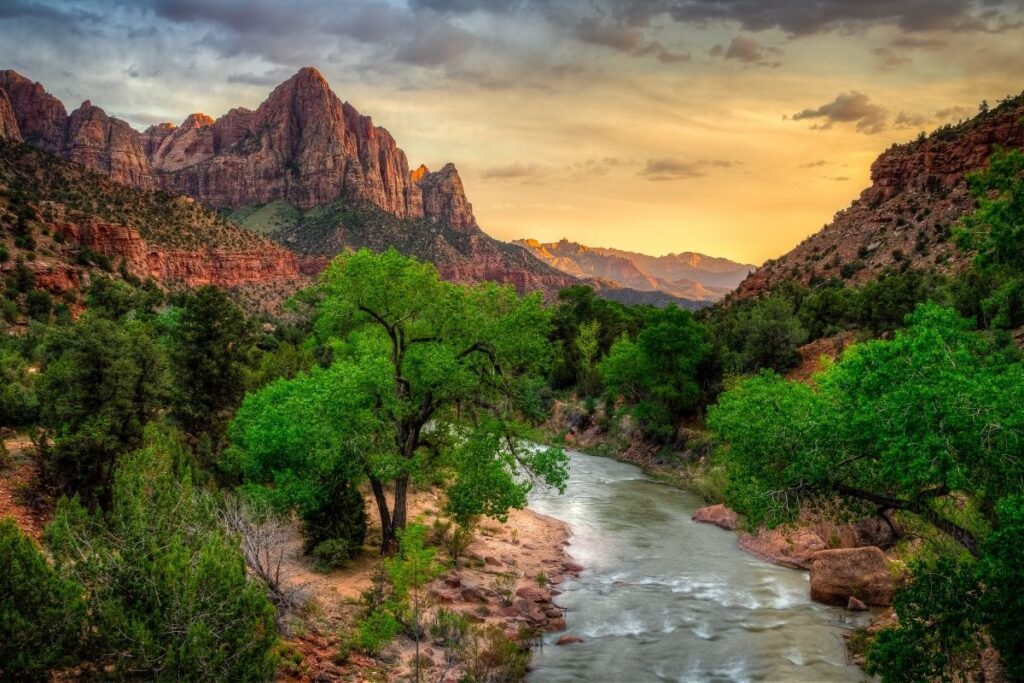
Other National Park Units in Utah
Here are the eight other National Park units in Utah.
- Cedar Breaks National Monument
- Dinosaur National Monument (CO, UT)
- Glen Canyon National Recreation Area (AZ, UT)
- Golden Spike National Historical Park
- Hovenweep National Monument (CO, UT)
- Natural Bridges National Monument
- Rainbow Bridge National Monument
- Timpanogos Cave National Monument
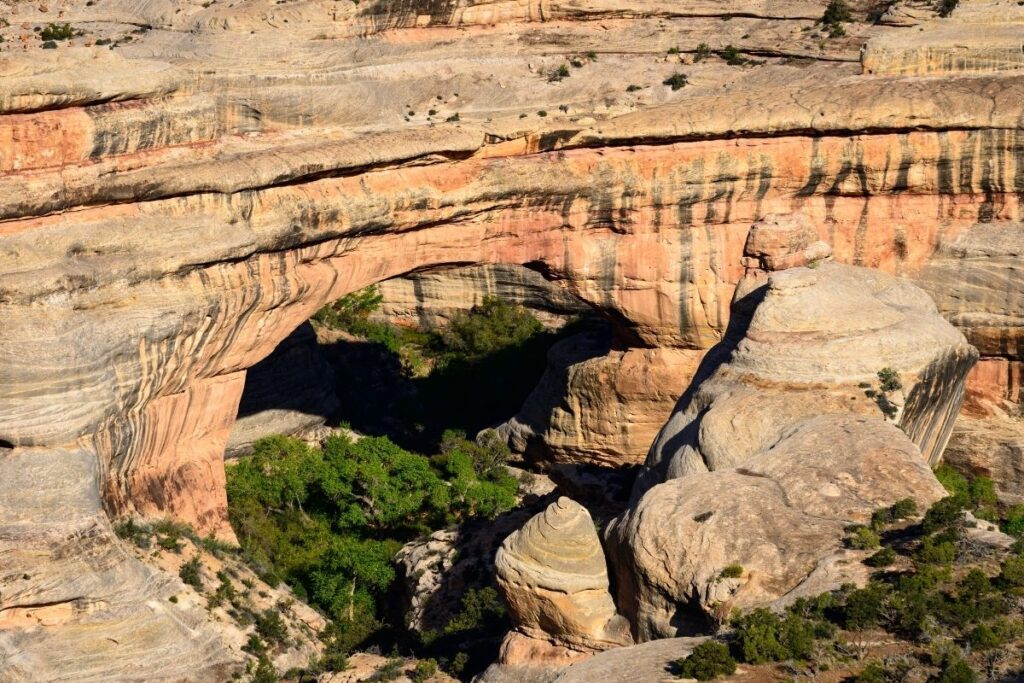
List of the National Parks in the Southwest
National Parks of the Southwest
- Arches National Park (UT)
- Big Bend National Park (TX)
- Black Canyon of the Gunnison National Park (CO)
- Bryce Canyon National Park (UT)
- Canyonlands National Park (UT)
- Capitol Reef National Park (UT)
- Carlsbad Caverns National Park (NM)
- Death Valley National Park (CA, NV)
- Grand Canyon National Park (AZ)
- Great Sand Dunes National Park (CO)
- Guadalupe Mountains National Park (TX)
- Joshua Tree National Park (CA)
- Mesa Verde National Park (CO)
- Petrified Forest National Park (AZ)
- Saguaro National Park (AZ)
- White Sands National Park (NM)
- Zion National Park (UT)
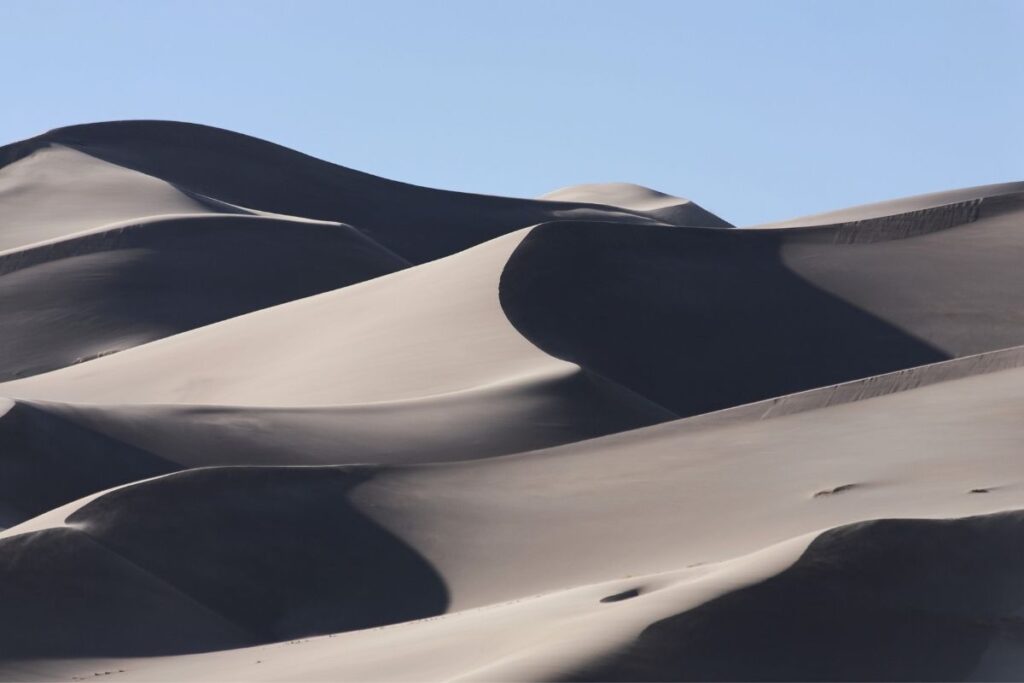
National Monuments of the Southwest
- Alibates Flint Quarries National Monument (TX)
- Aztec Ruins National Monument (NM)
- Bandelier National Monument (NM)
- Cabrillo National Monument (CA)
- Canyon De Chelly National Monument (AZ)
- Capulin Volcano National Monument (NM)
- Casa Grande Ruins National Monument (AZ)
- Castle Mountains National Monument (CA)
- Cedar Breaks National Monument (UT)
- César E. Chávez National Monument (CA)
- Chiricahua National Monument (AZ)
- Colorado National Monument (CO)
- Coronado National Memorial (AZ)
- Dinosaur National Monument (CO, UT)
- El Malpais National Monument (NM)
- El Morro National Monument (NM)
- Florissant Fossil Beds National Monument (CO)
- Fort Union National Monument (NM)
- Gila Cliff Dwellings National Monument (NM)
- Hohokam Pima National Monument (AZ)
- Hovenweep National Monument (CO, UT)
- Montezuma Castle National Monument (AZ)
- Natural Bridges National Monument (UT)
- Navajo National Monument (AZ)
- Organ Pipe Cactus National Monument (AZ)
- Petroglyph National Monument (NM)
- Pipe Spring National Monument (AZ)
- Rainbow Bridge National Monument (UT)
- Salinas Pueblo Missions National Monument (NM)
- Sunset Crater Volcano National Monument (AZ)
- Timpanogos Cave National Monument (UT)
- Tonto National Monument (AZ)
- Tule Springs Fossil Beds National Monument (NV)
- Tuzigoot National Monument (AZ)
- Waco Mammoth National Monument (TX)
- Walnut Canyon National Monument (AZ)
- Wupatki National Monument (AZ)
- Yucca House National Monument (CO)
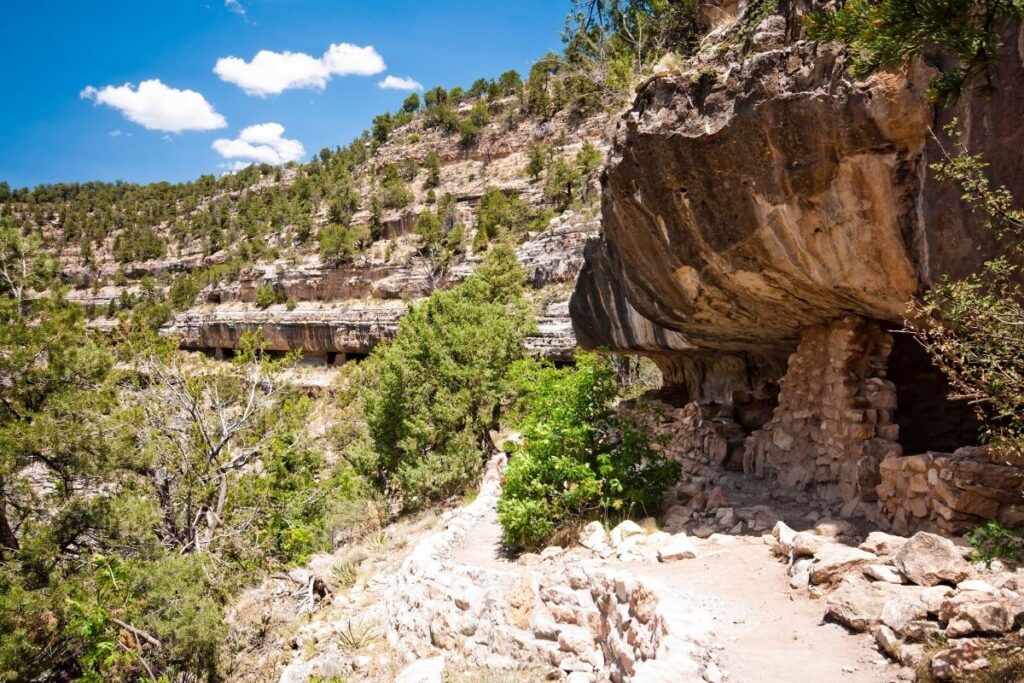
National Preserves of the Southwest
- Big Thicket National Preserve (TX)
- Great Sand Dunes National Preserve (CO)
- Mojave National Preserve (CA)
- Valles Caldera National Preserve (NM)
National Historical Parks of the Southwest
- Chaco Culture National Historical Park (NM)
- Golden Spike National Historical Park (UT)
- Lyndon B. Johnson National Historical Park (TX)
- Manhattan Project National Historical Park (NM, TN, WA)
- Palo Alto Battlefield National Historical Park (TX)
- Pecos National Historical Park (NM)
- San Antonio Missions National Historical Park (TX)
- Tumacacori National Historical Park (AZ)
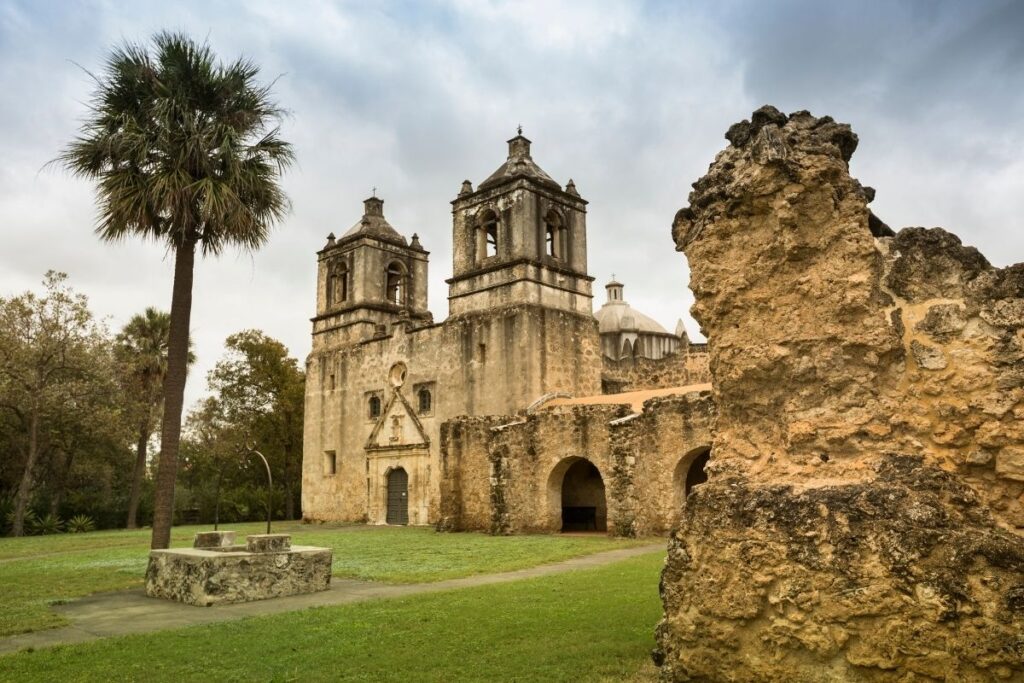
National Historic Sites of the Southwest
- Bent’s Old Fort National Historic Site (CO)
- Fort Bowie National Historic Site (AZ)
- Fort Davis National Historic Site (TX)
- Fort Smith National Historic Site (OK)
- Hubbell Trading Post National Historic Site (AZ)
- Manzanar National Historic Site (CA)
- Sand Creek Massacre National Historic Site (CO)
- Washita Battlefield National Historic Site (OK)
National Memorials of the Southwest
- Chamizal National Memorial (TX)
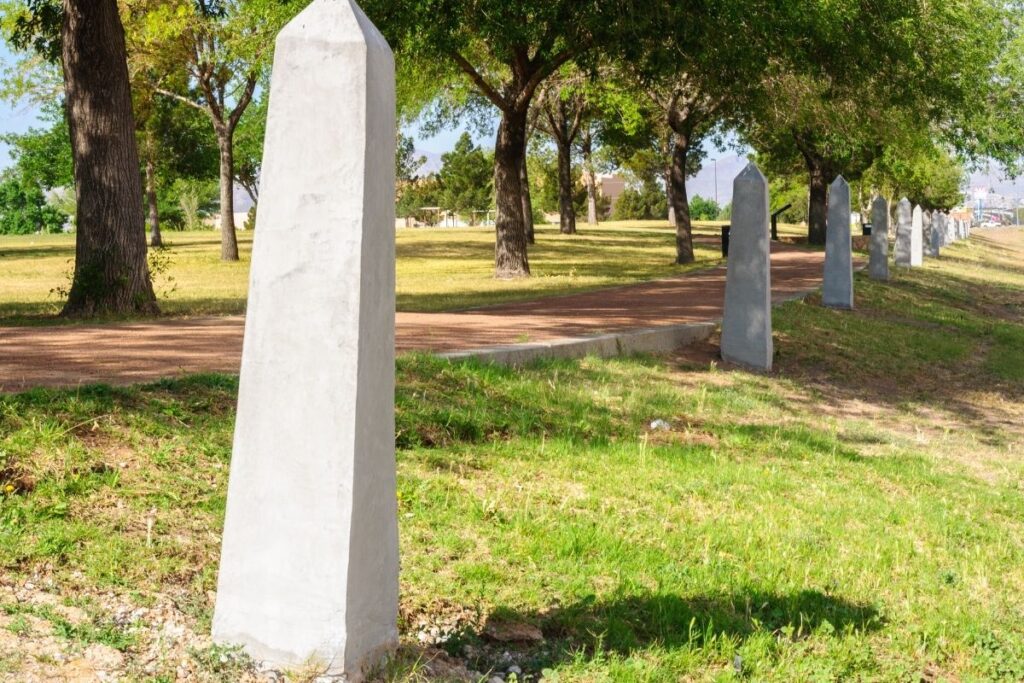
National Recreation Areas of the Southwest
- Amistad National Recreation Area (TX)
- Chickasaw National Recreation Area (OK)
- Curecanti National Recreation Area (CO)
- Glen Canyon National Recreation Area (AZ, UT)
- Lake Meredith National Recreation Area (TX)
- Santa Monica Mountains National Recreation Area (CA)
National Seashores of the Southwest
- Padre Island National Seashore (TX)
National Rivers of the Southwest
- Rio Grande Wild and Scenic River (TX)
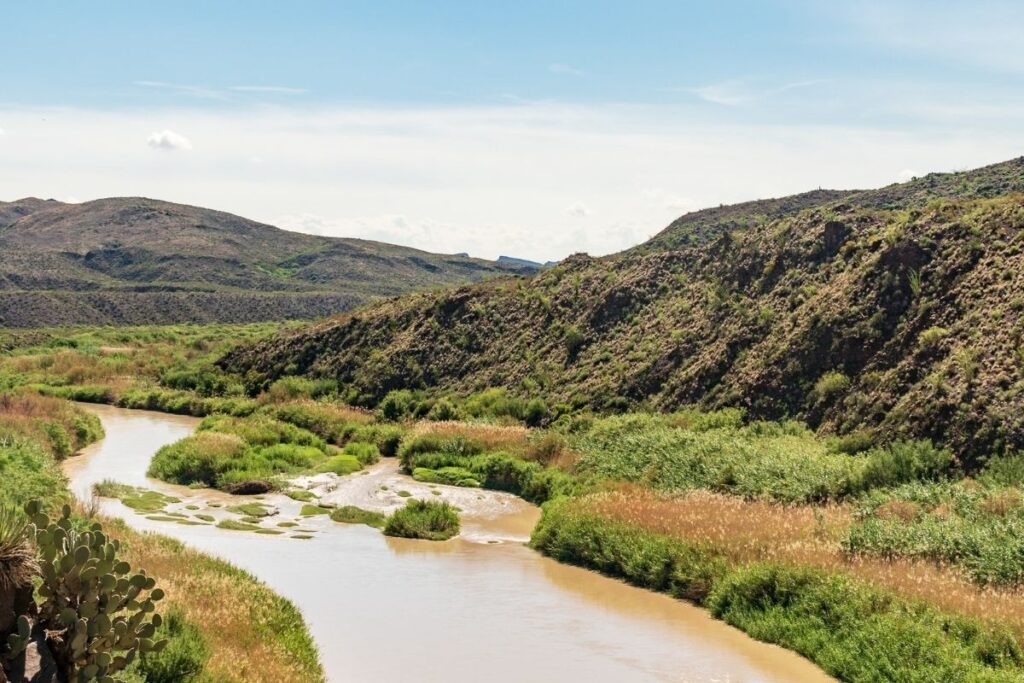
Associated Units of the Northeast
Associated National Trails of the Southwest
- California National Historic Trail (CA, CO, ID, KS, MO, NE, NV, OR, UT, WY)
- EL Camino Real de los Tejas National Historic Trail (TX)
- El Camino Real de Tierra Adentro National Historic Trail (NM, TX)
- Juan Bautista de Anza National Historic Trail (AZ, CA)
- Mormon Pioneer National Historic Trail (IL, IA, NE, UT, WY)
- Old Spanish National Historic Trail (AZ, CA, CO, NV, NM, UT)
- Pony Express National Historic Trail (CA, CO, KS, MO, NE, NV, UT, WY)
- Santa Fe National Historic Trail (CO, KS, MO, NM, OK)
- Trail of Tears National Historic Trail (OK)
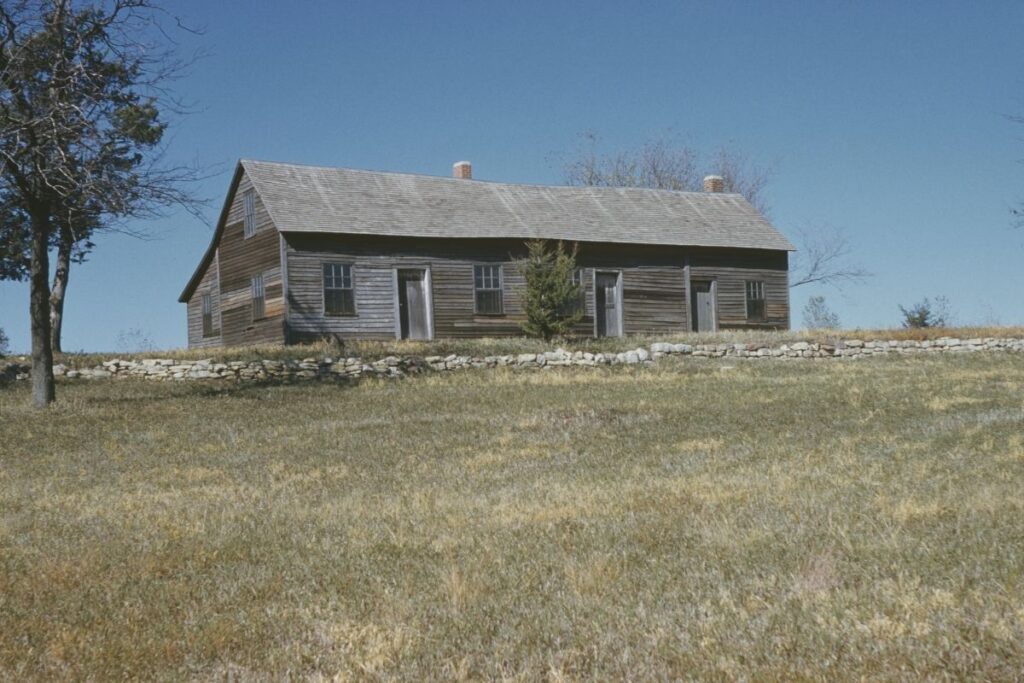
Associated National Monument of the Southwest
- Grand Canyon – Parashant National Monument (AZ)
Associated National Memorial of the Southwest
- Oklahoma City National Memorial (OK)
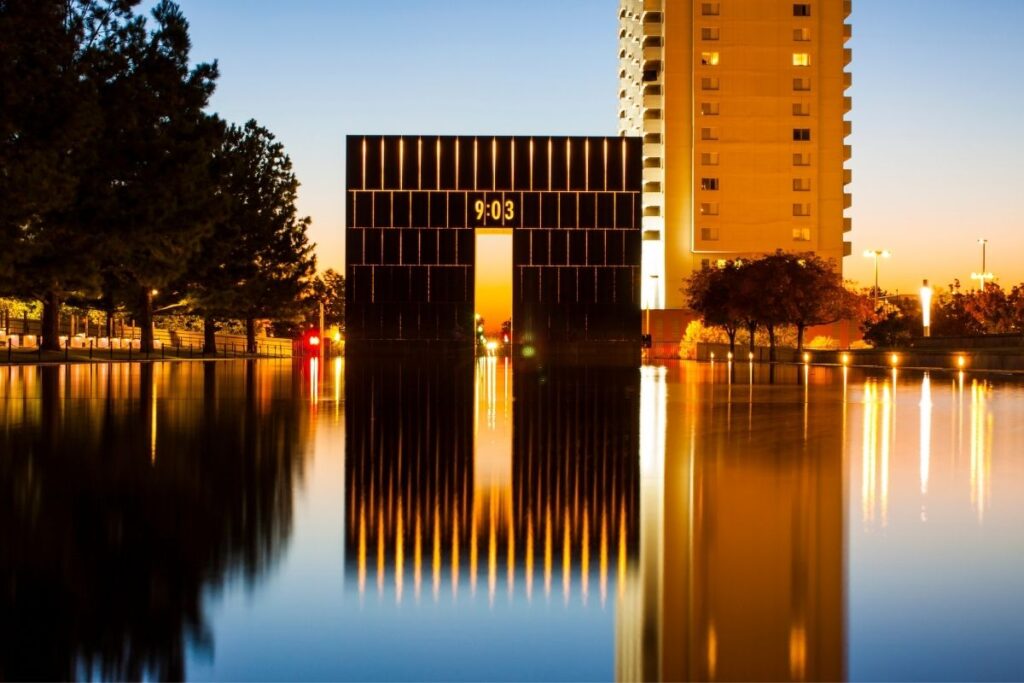
Final Thoughts on the Southwest National Parks
I hope you have learned a little bit about the National Parks of the Southwest and are ready to get out and explore the Southwestern National Parks. If you are interested in the National Parks of other regions click below;
- Northeast National Parks
- Southeast National Parks
- Midwest National Parks
- Intermountain National Parks
- Southwest National Parks
- Pacific-West National Parks
- Alaska National Parks
Pin for Later: The Definitive List of National Parks in the Southwest (2021 Update)

Jennifer Melroy
Hi, I'm Jennifer!
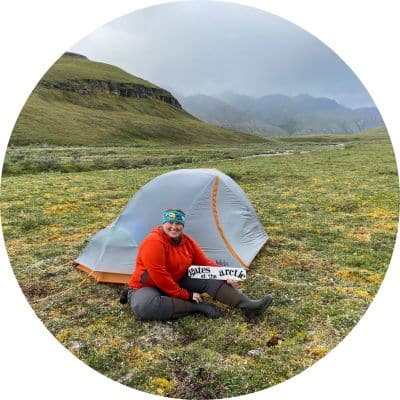
Welcome to the wonderful world of National Parks. I'm here to help you plan your NEXT amazing adventure through the United States National Parks and beyond. I want the national parks to be accessible to all.
I live in Tennessee, and when I'm home, you can find me hiking in the Smokies and the Cumberland Plateau.
58/63 National Parks
250+/423 National Park Units
Want to know more? Start Here.
Explore More
ACKNOWLEDGEMENT OF LAND
On this site, we promote travel to the United States and beyond that are the traditional lands of Indigenous and First Nations peoples.
With respect, I make a formal land acknowledgment, extending my appreciation and respect to these lands’ past and present people.
To learn more about the people who call these lands home, I invite you to explore Native Land.
DISCLAIMER
National Park Obsessed assumes no responsibility or liability for any errors or omissions in the content of this site (NationalParkObsessed.com). The information contained in this site is provided with no guarantees of completeness, accuracy, usefulness or timeliness. You are encouraged to conduct your own due diligence before acting on the information provided on this site and should not rely on the opinions expressed here.
There is an inherent risk in all outdoor recreation activities, the reader assumes all responsibility for their own personal safety.
DISCLOSURE
We are a participant in the Amazon Services LLC Associates Program, an affiliate program designed to provide a means for us to earn fees by linking to Amazon.com and affiliated sites.
Privacy Policy • About Us • Contact
Select stock photography provided depositphotos
Copyright ©2023 National Park Obsessed, LLC
Privacy Overview
Last Updated on 22 Jan 2022 by Jennifer Melroy
